Desi Cows
Milk is of two types A1 and A2.
Desi (Indian Native ) Cows produce A2 milk only.
All other breeds like Jersey, HF etc produce A1 milk only.
A1 milk is very harmful to humans, whereas A2 milk is the best for human consumption.
You can refer the book ‘DEVIL IN THE MILK” authored by Mr.K.B.Woodford. He has done an in depth clinical research on A1 and A2 milk and finally concluded that.
A1 MILK IS MORE DANGEROUS THAN POISON.
The Differences between A1 and A2 are tabled below:
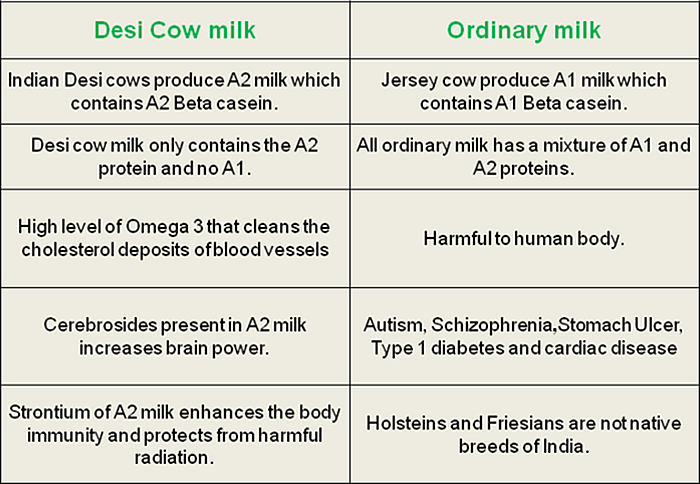
LIST OF DESI (INDIAN NATIVE) COWS ALONG WITH THEIR COMPLETE DETAILS
1. HIGH MILK ( MILCH) BREEDS
- GIR ( Gyr, Bhodali, Desan, Gujarati, Kathiawari, Sorthi, and Surati )
-
ORIGIN :Gujarat
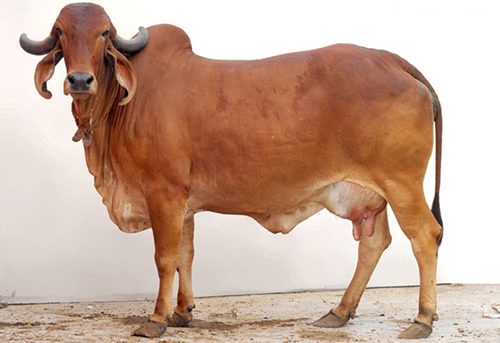
Cow
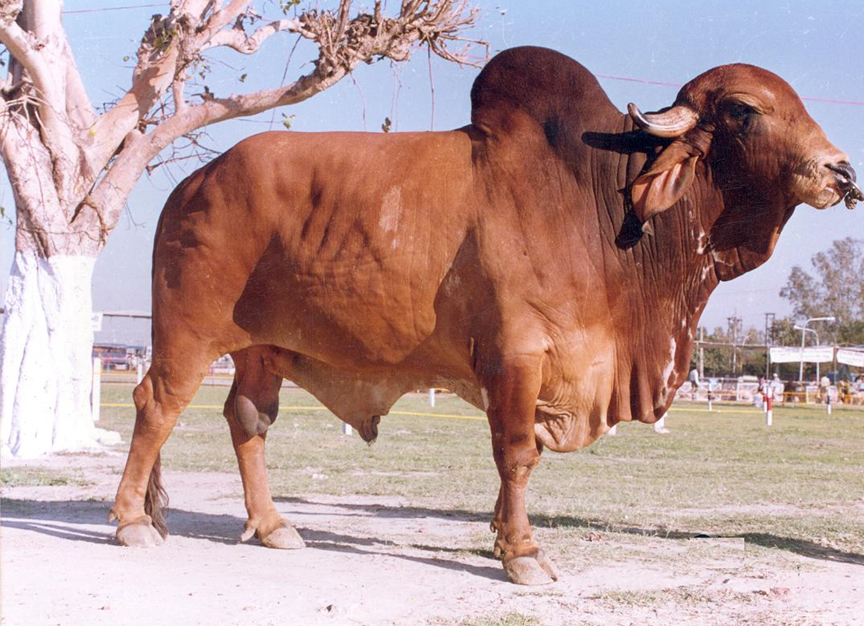
Bull
 Saurashtra region of Gujarat specially area in and around Gir forest.
Saurashtra region of Gujarat specially area in and around Gir forest.
 Gir cows are good milk producers. Bullocks can drag heavy loads on all kinds of soils, be it sandy, black or rocky.
Gir cows are good milk producers. Bullocks can drag heavy loads on all kinds of soils, be it sandy, black or rocky.
 Named after the Gir forest, the geographical/origin of the breed
Named after the Gir forest, the geographical/origin of the breed
 It is a hardy animal and can survive and produce in difficult environment
It is a hardy animal and can survive and produce in difficult environment
 Most of the Gir aninmals are pure red though some are speckled red.
Most of the Gir aninmals are pure red though some are speckled red.
 Long and pendulous ears folded like a leaf. Ears hang all the time and their inside face forward.
Long and pendulous ears folded like a leaf. Ears hang all the time and their inside face forward.
 Gir cattle are largely bred by professional breeders known as Rabaris, Bhanoads, Maldharis, Ahirs and Charans. Calves are allowed to suck for 8 to 12 months. Milking cows are usually retained in the village while dry cows and young stock are sent for grazing. Animals are herded in a field for 3 or 4 nights by the farmers as it provides manure in the form of dung and urine.
Gir cattle are largely bred by professional breeders known as Rabaris, Bhanoads, Maldharis, Ahirs and Charans. Calves are allowed to suck for 8 to 12 months. Milking cows are usually retained in the village while dry cows and young stock are sent for grazing. Animals are herded in a field for 3 or 4 nights by the farmers as it provides manure in the form of dung and urine.
- RATHI
-
ORIGIN : Rajasthan
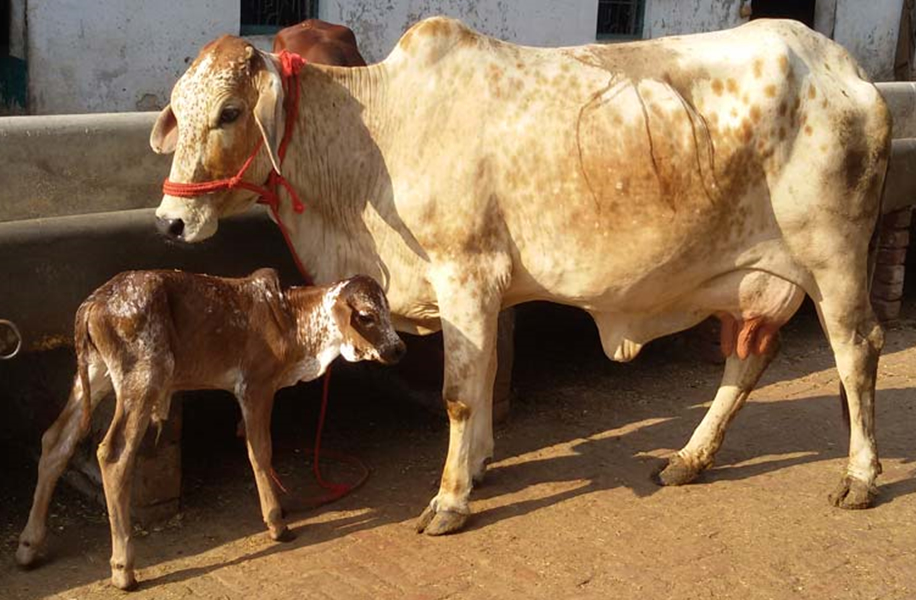
Cow
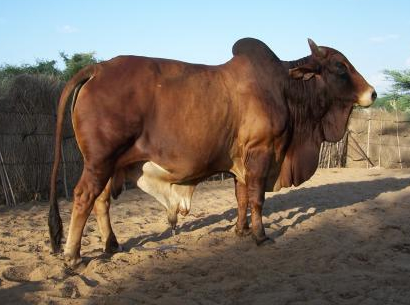
Bull
 Rathi animals are particularly concentarted in Loonkaransar tehsil of Bikaner district which is also known as Rathi tract.
Rathi animals are particularly concentarted in Loonkaransar tehsil of Bikaner district which is also known as Rathi tract.
 It takes its name from a pastroal tribe called Raths who are Muslims of Rajput extraction and lead a nomadic life. Rathi cattle seems to have originated from the mixture of Sahiwal, Red Sindhi, Tharparkar and Dhanni breeds apparently with a preponderance of Sahiwal blood.
It takes its name from a pastroal tribe called Raths who are Muslims of Rajput extraction and lead a nomadic life. Rathi cattle seems to have originated from the mixture of Sahiwal, Red Sindhi, Tharparkar and Dhanni breeds apparently with a preponderance of Sahiwal blood.
 The animals are usually brown with white patches all over the body, but animals having completely brown, or black coat with white patches are often encountered. The lower body parts are generally lighter in colour as compareed to the rest of body.
The animals are usually brown with white patches all over the body, but animals having completely brown, or black coat with white patches are often encountered. The lower body parts are generally lighter in colour as compareed to the rest of body.
 Face - broad between eyes and slightly dished. Dewlap - Fine and loose.Tail - long, fine tapering to a good black or white switch well below the hock.
Face - broad between eyes and slightly dished. Dewlap - Fine and loose.Tail - long, fine tapering to a good black or white switch well below the hock.
- RED KANDHARI ( Lakhalbunda )
-
ORIGIN : MAHARASHTRA
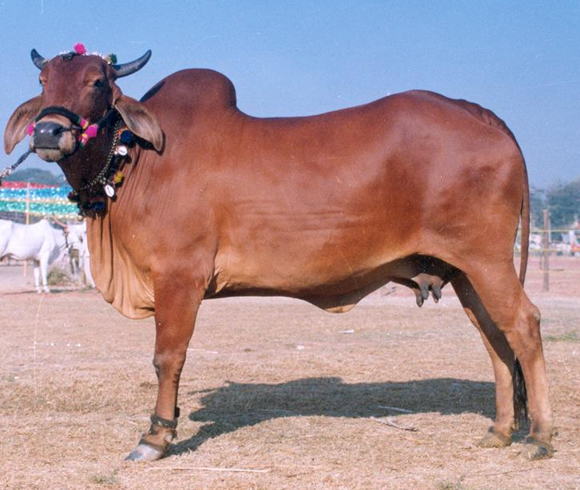
Cow
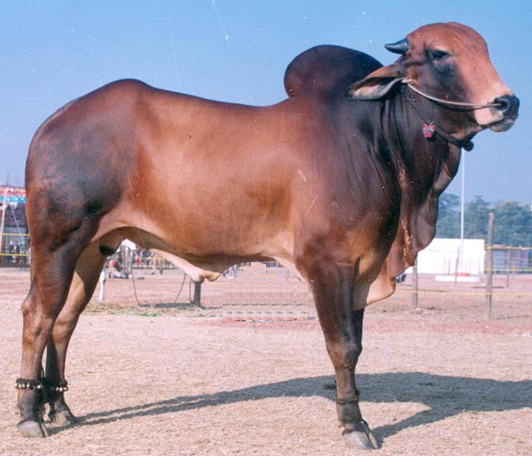
Bull
 Pure Red Kandhari animals are found in Kandhar, Mukhed, Nanded and Biloli tehsils of Nanded distrcit; Ahmadpur, Parli and Hingoli tehsils of Latur district.
Pure Red Kandhari animals are found in Kandhar, Mukhed, Nanded and Biloli tehsils of Nanded distrcit; Ahmadpur, Parli and Hingoli tehsils of Latur district.
 The breed could have been named by Raja Somdeori in memory of his father Raja Kanhar as Red Kanhari, now misnomered as Red Kandhari. This breed having red colour and common in Kandhar tehsil of Nanded district also naturally acquires the name Red Kandhari.
The breed could have been named by Raja Somdeori in memory of his father Raja Kanhar as Red Kanhari, now misnomered as Red Kandhari. This breed having red colour and common in Kandhar tehsil of Nanded district also naturally acquires the name Red Kandhari.
 The colour is uniform deep dark red, but variations from a dull red to almost brown are also found. Bulls as a rule, are a shade darker than cows.
The colour is uniform deep dark red, but variations from a dull red to almost brown are also found. Bulls as a rule, are a shade darker than cows.
 Herd size is small. Generally animals are maintained on grazing alone. Small quantities of concentrate is offered only to bullocks, bull calves and milking females. Calves are not weaned. Male calves are nursed better and longer as compared to female calves. Most of the animals are given individual care.
Herd size is small. Generally animals are maintained on grazing alone. Small quantities of concentrate is offered only to bullocks, bull calves and milking females. Calves are not weaned. Male calves are nursed better and longer as compared to female calves. Most of the animals are given individual care.
- RED SINDHI ( Malir (Baluchistan), Red Karachi and Sindhi)
-
ORIGIN : BALUCHISTAN (Now in Pakistan)
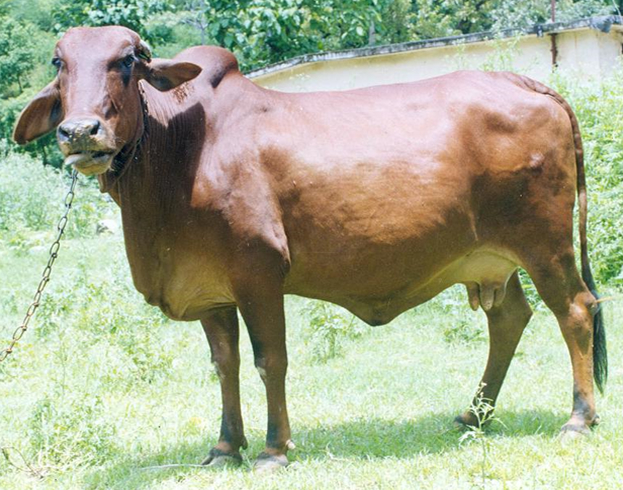
Cow
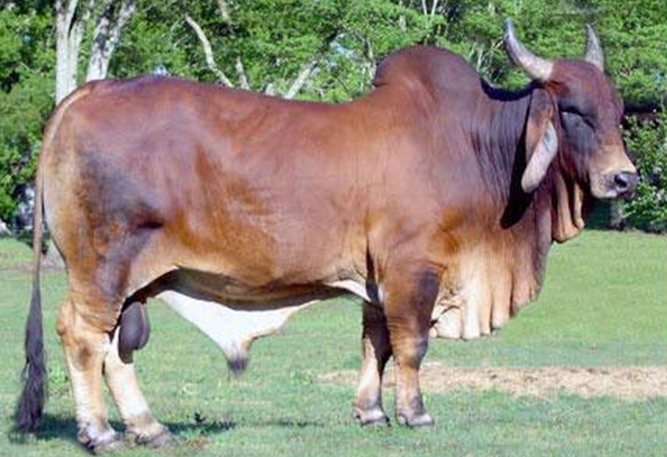
Bull
 The original breeding tract is in Pakistan but some organised herds are available in Orissa, Tamil nadu, Bihar, Kerala and Assam states of India.
The original breeding tract is in Pakistan but some organised herds are available in Orissa, Tamil nadu, Bihar, Kerala and Assam states of India.
 Red Sindhi is considered to have originated from Las Bela cattle found in the state of Bela, Baluchistan.
Red Sindhi is considered to have originated from Las Bela cattle found in the state of Bela, Baluchistan.
 This breed has distinctly red colour. Red shades vary from dark red to dim yellow. Though patches of white are seen on dewlap and sometime on forehead, no large white patches are present on the body. In bulls, colour is dark on the shoulders and thighs.
This breed has distinctly red colour. Red shades vary from dark red to dim yellow. Though patches of white are seen on dewlap and sometime on forehead, no large white patches are present on the body. In bulls, colour is dark on the shoulders and thighs.
 These are kept under intensive management conditions at organised farms.
These are kept under intensive management conditions at organised farms.
- SAHIWAL ( Lambi Bar, Lola, Montgomery, Multani and Teli )
-
ORIGIN : Punjab/Rajasthan
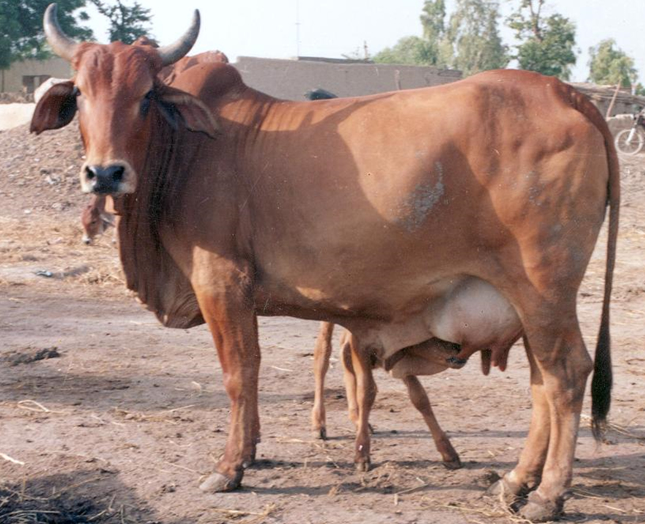
Cow
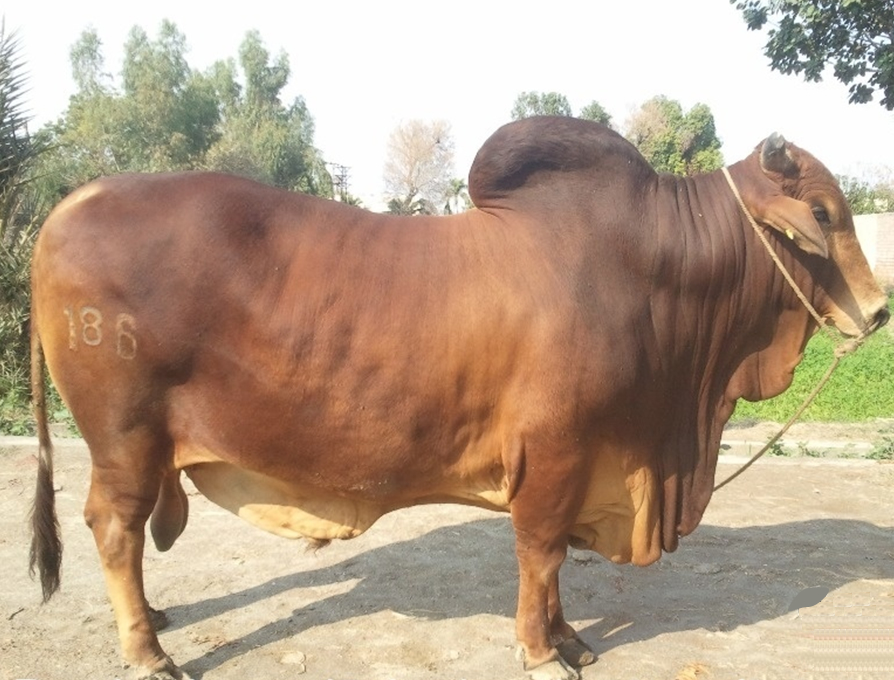
Bull
 A few herds of pure Sahiwal cattle are available aound Fazilka and Abohar towns of Ferozepur district.
A few herds of pure Sahiwal cattle are available aound Fazilka and Abohar towns of Ferozepur district.
 One of the best dairy breed of zebu cattle. It is being utilized for improvement of local stock.
One of the best dairy breed of zebu cattle. It is being utilized for improvement of local stock.
 The breed derives its name from Sahiwal area in Montgomery district of Punjab (Pakistan.
The breed derives its name from Sahiwal area in Montgomery district of Punjab (Pakistan.
 Brownish red colour, shades may vary from a mahogany red brown to more greyish red. Extremities in bulls are darker than rest of body colour.Occasionally there are white patches.
Brownish red colour, shades may vary from a mahogany red brown to more greyish red. Extremities in bulls are darker than rest of body colour.Occasionally there are white patches.
 Pale red colour, short horns and loose skin.
Pale red colour, short horns and loose skin.
 Animals are not provided with any type of house. They are kept loose in an open area. Only calves are provided with bush enclosers. Animals are taken for grazing in the morning. Milking cows return early while the rest return at sun set. They are also fed green fodder. Milking cows are provided supplementry feeding in the form of cotton seed, barley and oil cake. Feed is given in soaked form at the time of milking. Calves are reared on whole milk up to 1 month of age after which some green fodder is also fed. Calves are allowed to suck 1-2 teats up to 6 months of age.
Animals are not provided with any type of house. They are kept loose in an open area. Only calves are provided with bush enclosers. Animals are taken for grazing in the morning. Milking cows return early while the rest return at sun set. They are also fed green fodder. Milking cows are provided supplementry feeding in the form of cotton seed, barley and oil cake. Feed is given in soaked form at the time of milking. Calves are reared on whole milk up to 1 month of age after which some green fodder is also fed. Calves are allowed to suck 1-2 teats up to 6 months of age.
 Because of its desirable traits, it is being utilised widely in many warm humid countries of the world for improvement of local stock or for initial crossbreeding of indigenous stock before undertaking upgrading with European breeds.
Because of its desirable traits, it is being utilised widely in many warm humid countries of the world for improvement of local stock or for initial crossbreeding of indigenous stock before undertaking upgrading with European breeds.
- DEONI ( Surti, Dongarpati, Dongari, Wannera, Waghyd, Balankya and Shevera )
-
ORIGIN : Maharashtra/Karnataka
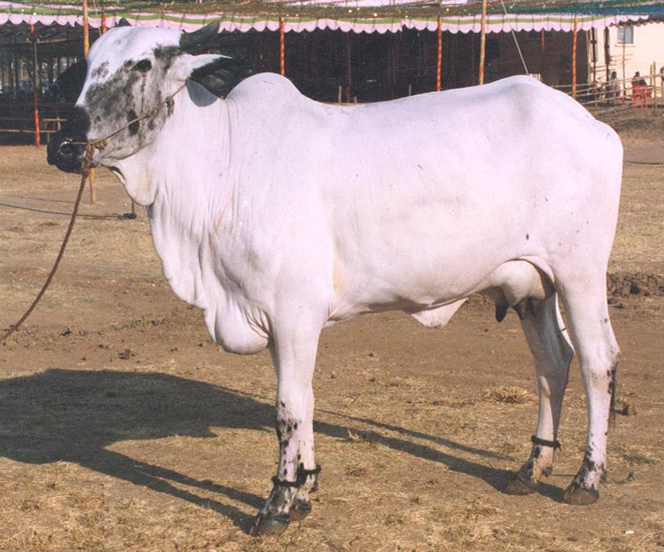
Cow
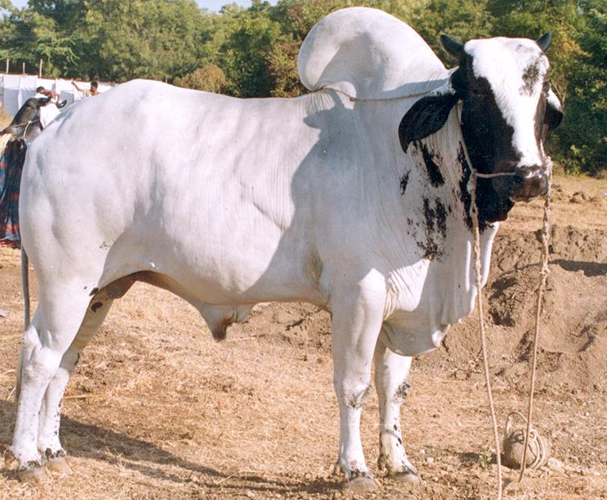
Bull
 The breeding tract lies in the Balaghat range of Sahyadri hills extending from Kannad taluk of Aurangabad to Deglur taluk of Marathwada region of Maharashtra state.The actual place of origin is Deoni, Udgir and Ahmadpur taluks of Latur district.
The breeding tract lies in the Balaghat range of Sahyadri hills extending from Kannad taluk of Aurangabad to Deglur taluk of Marathwada region of Maharashtra state.The actual place of origin is Deoni, Udgir and Ahmadpur taluks of Latur district.
 Deoni bullocks are preferred for heavy work. Deoni bullocks reach the maximum potentional at around 5 to 6 year of age and maintain it effectively up to 12 year of age.
Deoni bullocks are preferred for heavy work. Deoni bullocks reach the maximum potentional at around 5 to 6 year of age and maintain it effectively up to 12 year of age.
 Believed to have been developed from Gir cattle.This breed has drived its name from the habitat i.e. Deoni taluk of Latur district.
Believed to have been developed from Gir cattle.This breed has drived its name from the habitat i.e. Deoni taluk of Latur district.
 Body colour is usually spotted black and white. This breed has three strains viz. 1- Complete white(Balankya). 2.- Comlete white with partial black face (Wannera). 3-Black and white spotted(Waghyd or Shevera)
Body colour is usually spotted black and white. This breed has three strains viz. 1- Complete white(Balankya). 2.- Comlete white with partial black face (Wannera). 3-Black and white spotted(Waghyd or Shevera)
 Black and white spotted body colour, drooping ears, prominent and slightly bulging forehead
Black and white spotted body colour, drooping ears, prominent and slightly bulging forehead
 Animals are housed mostly in open houses. Most of the animals are given individual care. Calves are not weaned. Males are nursed better and longer as compared to female calves. Animals are taken to pastures during day time and generally maintained on grazing only. Bullocks, bull calves and milking females are given some crop residues and concentrate.
Animals are housed mostly in open houses. Most of the animals are given individual care. Calves are not weaned. Males are nursed better and longer as compared to female calves. Animals are taken to pastures during day time and generally maintained on grazing only. Bullocks, bull calves and milking females are given some crop residues and concentrate.
2. NORMAL ( DUAL) BREEDS
- ALAMBADI
-
ORIGIN : TAMIL NADU

Cow
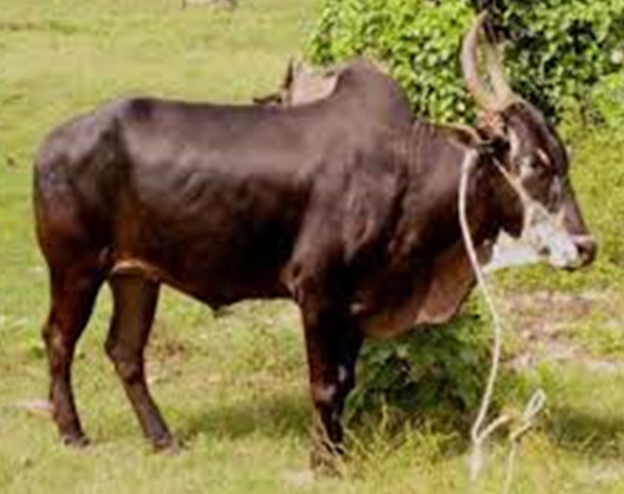
Bull
 Alambadi cattle is an indigenous, wonderful breed originated from Alambadi of Dharmapuri district in Tamil Nadu state of India. Now Alambadi is a quite rare breed. This cattle breed is mainly raised in the hilly regions of modern-day Tamil Nadu.
Alambadi cattle is an indigenous, wonderful breed originated from Alambadi of Dharmapuri district in Tamil Nadu state of India. Now Alambadi is a quite rare breed. This cattle breed is mainly raised in the hilly regions of modern-day Tamil Nadu.
 Alambadi cattle is a very hardy animal, and is very useful in ploughing. And can withstand all climatic conditions. Alambadi cows give good amount of milk
Alambadi cattle is a very hardy animal, and is very useful in ploughing. And can withstand all climatic conditions. Alambadi cows give good amount of milk
 Farmers and breeders are complaining that the reason for the extinction of breed is due to the banning of bio-cultural sports like Jallikattu, Rekla racing and usage of exotic foreign crossbred cows.
Farmers and breeders are complaining that the reason for the extinction of breed is due to the banning of bio-cultural sports like Jallikattu, Rekla racing and usage of exotic foreign crossbred cows.
 Alambadi breed is almost extinct and it is rare to find one. However there was a Conservation of Aalambadi breed Cattle Exhibition at Govindapady on 25 4 2015 visit the page below…
Alambadi breed is almost extinct and it is rare to find one. However there was a Conservation of Aalambadi breed Cattle Exhibition at Govindapady on 25 4 2015 visit the page below…
- BARGUR
-
ORIGIN : TAMIL NADU
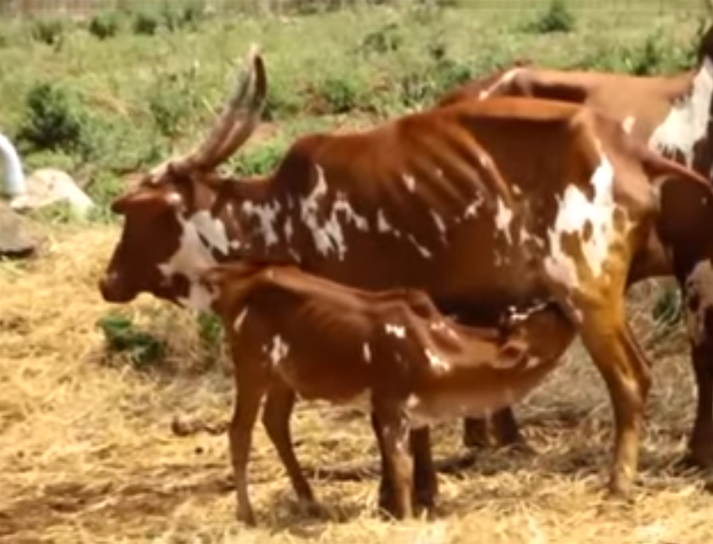
Cow
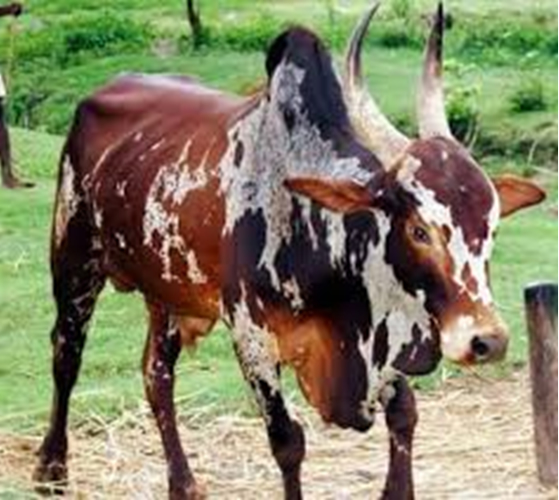
Bull
 This breed is found around Bargur hills in Bhavani taluk of Erode district.
This breed is found around Bargur hills in Bhavani taluk of Erode district.
 Animals are very sensitive and fiery in disposition and are difficult to train.They are light in built and are developed mainly for carrying out agricultural operations in the uneaven and hilly terrain. Cattle of this breed are unsurpassed in speed and endurance in trotting.
Animals are very sensitive and fiery in disposition and are difficult to train.They are light in built and are developed mainly for carrying out agricultural operations in the uneaven and hilly terrain. Cattle of this breed are unsurpassed in speed and endurance in trotting.
 Brown with white markings.
Brown with white markings.
 Animals are reared in the forest area in semi wild conditions and are penned in enclosures called pattys. They are tended by hired local tribal labours called lingaiys. Each patty has 50 to 200 heads of cattle. They remain in the interior of forest and graze on existing vegetation. They are brought back to villages for harvest operations only. All these cattle are driven to salt licks 43 Km north of Bargur by about January for a few days and then driven to forest again.
Animals are reared in the forest area in semi wild conditions and are penned in enclosures called pattys. They are tended by hired local tribal labours called lingaiys. Each patty has 50 to 200 heads of cattle. They remain in the interior of forest and graze on existing vegetation. They are brought back to villages for harvest operations only. All these cattle are driven to salt licks 43 Km north of Bargur by about January for a few days and then driven to forest again.
 The distinguishing morphological features of these cattle include its typical brown colour with white patches and being compact in size.
The distinguishing morphological features of these cattle include its typical brown colour with white patches and being compact in size.
- KANGAYAM
-
ORIGIN : TAMIL NADU
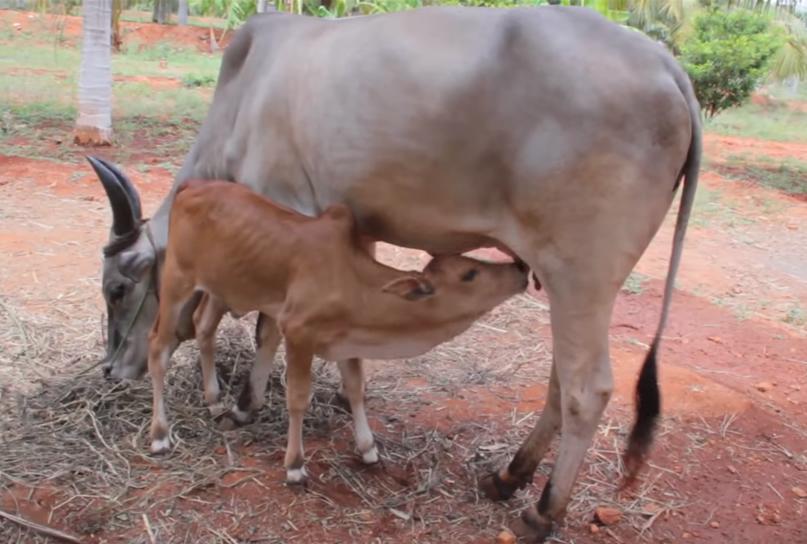
Cow
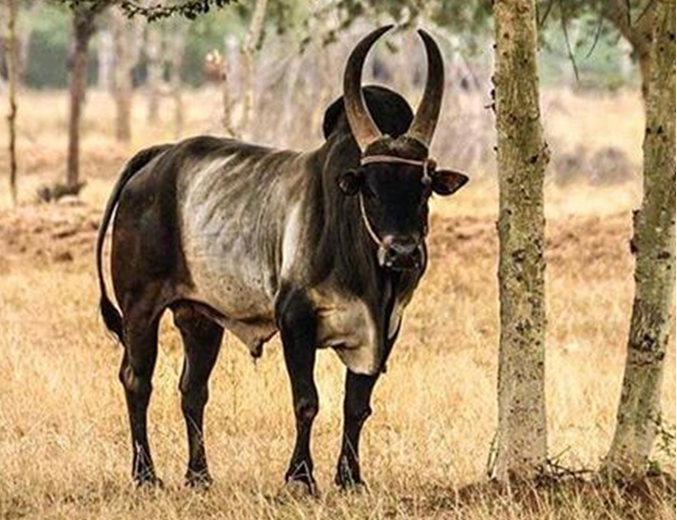
Bull
 Animals true to the type are available in Kangayam and Dharapuram taluks of Erode district, and Karur taluk of Karur district.
Animals true to the type are available in Kangayam and Dharapuram taluks of Erode district, and Karur taluk of Karur district.
 Bullocks have a good capacity for work and are used for all agricultural operations. Kangayam bullocks alone are used for sugarcane load hauling, though other draught breeds are available in the area.
Bullocks have a good capacity for work and are used for all agricultural operations. Kangayam bullocks alone are used for sugarcane load hauling, though other draught breeds are available in the area.
 This breed derives its name from its habitat - Kangayam taluk of Erode district -earlier part of Coimbatore district. This breed was developed by late Pattogar of Palayakottai. This breed resembles Umblachery breed.
This breed derives its name from its habitat - Kangayam taluk of Erode district -earlier part of Coimbatore district. This breed was developed by late Pattogar of Palayakottai. This breed resembles Umblachery breed.
 Coat is red at birth, but changes to grey at about 6 month of age. Bulls are grey with dark colour in hump, fore and hind quarters, face and legs. Bullocks are grey. Cows are grey or white and grey. The face of majority of cows is dark grey.
Coat is red at birth, but changes to grey at about 6 month of age. Bulls are grey with dark colour in hump, fore and hind quarters, face and legs. Bullocks are grey. Cows are grey or white and grey. The face of majority of cows is dark grey.
 Long horns nearly completing a circle, long hump and strong body.
Long horns nearly completing a circle, long hump and strong body.
 Kangayam cattle are traditionally reared on grazing in dry lands kept as pasture land by farmers for cattle and sheep in the breeding tract. The pasture land is divided into many paddocks by live fencing of a thorny shrub. A system of rotational and priority grazing is adopted. Velvaelam trees are also seen extensively in grazing areas. They provide shade to animals in rest during grazing. Calves are allowed to suck as much milk from their dams as they require up to 6 weeks. Later green grass is provided to the calves. However, weaning is never practised.
Kangayam cattle are traditionally reared on grazing in dry lands kept as pasture land by farmers for cattle and sheep in the breeding tract. The pasture land is divided into many paddocks by live fencing of a thorny shrub. A system of rotational and priority grazing is adopted. Velvaelam trees are also seen extensively in grazing areas. They provide shade to animals in rest during grazing. Calves are allowed to suck as much milk from their dams as they require up to 6 weeks. Later green grass is provided to the calves. However, weaning is never practised.
 Bullocks of this breed are preferred for transportation of sugarcane than those of other breeds found in this region like Hallikar and Alambadi. Transporation capacity of these bullocks is the main source of livelihood of their owners in and around sugar mills in this region.
Bullocks of this breed are preferred for transportation of sugarcane than those of other breeds found in this region like Hallikar and Alambadi. Transporation capacity of these bullocks is the main source of livelihood of their owners in and around sugar mills in this region.
- PULIKULAM ( Palingu maadu, Mani maadu, Jallikattu maadu, Kilakattu maadu )
-
ORIGIN : TAMIL NADU
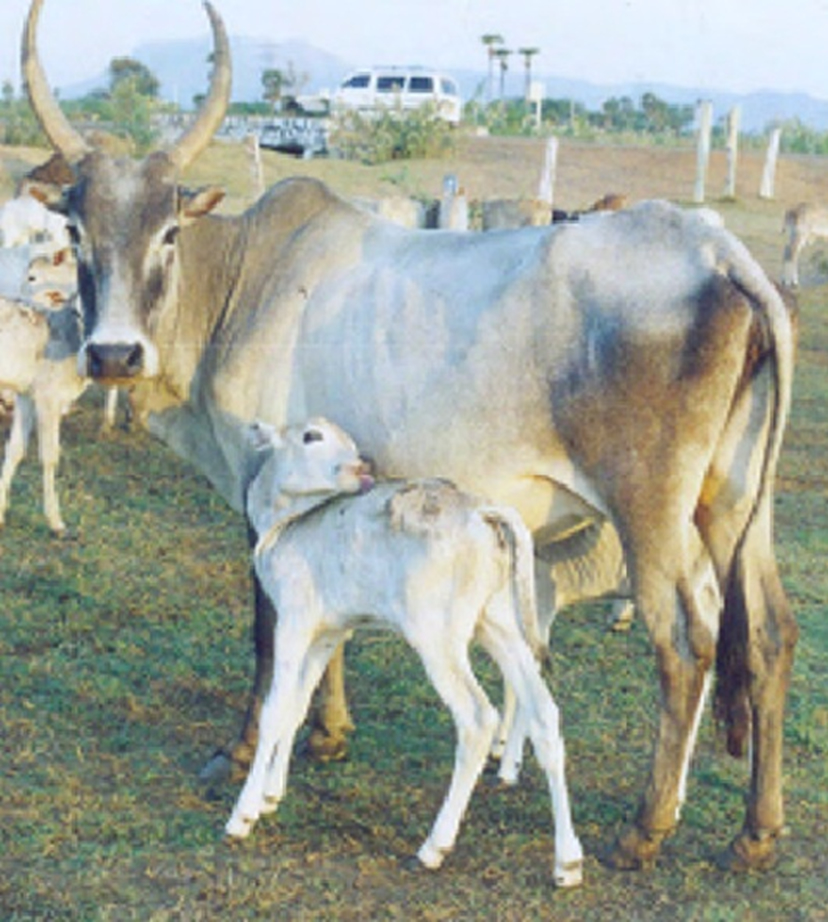
Cow
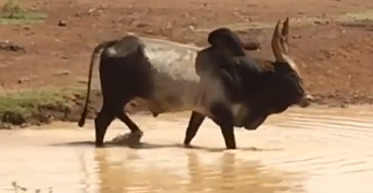
Bull
 Bulls are used in Bull embracing competition (Jallikattu) which is very popular game in the area.
Bulls are used in Bull embracing competition (Jallikattu) which is very popular game in the area.
 Originated from Pulikulam village
Originated from Pulikulam village
 The animals survive well on extensive grazing in the tropical climate of the area in the open housing system
The animals survive well on extensive grazing in the tropical climate of the area in the open housing system
 Dark grey in males and white or grey in females
Dark grey in males and white or grey in females
 Small size, compact body and short legs. Muzzle, eyelids, tail switch and hooves are black.Fore Head is broad and level with groove at centre.Hump large in males and small in females. Udder not well developed.
Small size, compact body and short legs. Muzzle, eyelids, tail switch and hooves are black.Fore Head is broad and level with groove at centre.Hump large in males and small in females. Udder not well developed.
 Mostly maintained by Konar and Thevar communities. Herd size varies from 100-700 with an average of 1bout 400 cattle. Small herds are pooled togther for logistical and economic reasons.
Mostly maintained by Konar and Thevar communities. Herd size varies from 100-700 with an average of 1bout 400 cattle. Small herds are pooled togther for logistical and economic reasons.
 Milking is done only in 10-15 cows in a herd to meet the requirements of herdsmen. Daily milk yield ranges from 0.5 to 2 kg with an average of around 1.25kg.
Milking is done only in 10-15 cows in a herd to meet the requirements of herdsmen. Daily milk yield ranges from 0.5 to 2 kg with an average of around 1.25kg.
- UMBLACHERY ( Jathimadu, Mottaimadhu, Molaimadhu, Southern, Tanjore, Therkuthimadhu )
-
ORIGIN : TAMIL NADU
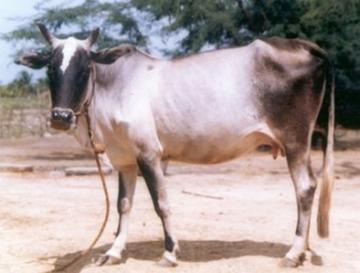
Cow
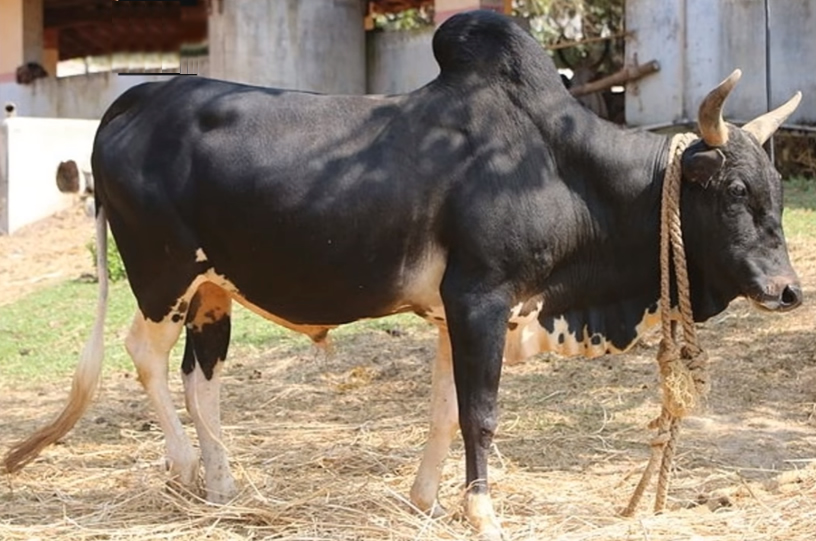
Bull
 All unions of Thiruvarur district; Keelalyur, Kelvelur, Nagapattinam, Thalaignayar, Thirumarugal and Vedaranyam unions of Nagapatrtinam district of Tamil Nadu.
All unions of Thiruvarur district; Keelalyur, Kelvelur, Nagapattinam, Thalaignayar, Thirumarugal and Vedaranyam unions of Nagapatrtinam district of Tamil Nadu.
 These are light built draught animals developed for work in marshy paddy fields.
These are light built draught animals developed for work in marshy paddy fields.
 It derives its name from its home tract, Umbalachery a small village in Thalaignayar union in Nagapattinam district.
It derives its name from its home tract, Umbalachery a small village in Thalaignayar union in Nagapattinam district.
 Umbalachery breed is very well suited for working in the alluvial type of soil available in this area.
Umbalachery breed is very well suited for working in the alluvial type of soil available in this area.
 Red at birth which changes to grey at three to four months of age. Bulls are dark grey with black extremities. Bullocks are grey in colour with light dark extremities. Cows are grey in colour and light dark grey is present in face, neck and hip region.
Red at birth which changes to grey at three to four months of age. Bulls are dark grey with black extremities. Bullocks are grey in colour with light dark extremities. Cows are grey in colour and light dark grey is present in face, neck and hip region.
 White markings on face, limbs and tail. All the legs below hocks have white marks either as Socks or as Stockings. Even a portion of hooves is white.
White markings on face, limbs and tail. All the legs below hocks have white marks either as Socks or as Stockings. Even a portion of hooves is white.
 In the day time, the animals are tethered in the wood packs or tree trunks. Most of the cows are not milked. Calves are allowed to suck their dams. Paddy straw is the main fodder. Bullocks and milking females are offered GNC/ sesame oilcakes. Rice bran and cotton seed are also fed. Animals are also sent to grazing. Herdsmen collect animals from various households in January or February and graze them for about 6 months. Usually herd strength of such groups ranges from 250 to 400 animals. They are herded together for manuring the fields.
In the day time, the animals are tethered in the wood packs or tree trunks. Most of the cows are not milked. Calves are allowed to suck their dams. Paddy straw is the main fodder. Bullocks and milking females are offered GNC/ sesame oilcakes. Rice bran and cotton seed are also fed. Animals are also sent to grazing. Herdsmen collect animals from various households in January or February and graze them for about 6 months. Usually herd strength of such groups ranges from 250 to 400 animals. They are herded together for manuring the fields.
- BACHAUR ( Bhutia )
-
ORIGIN : BIHAR
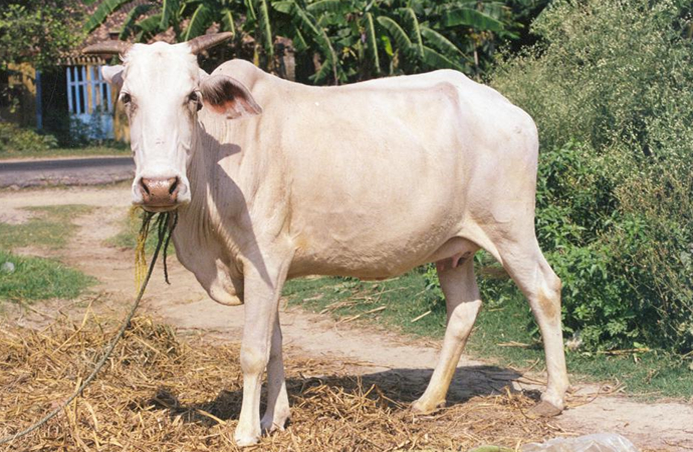
Cow
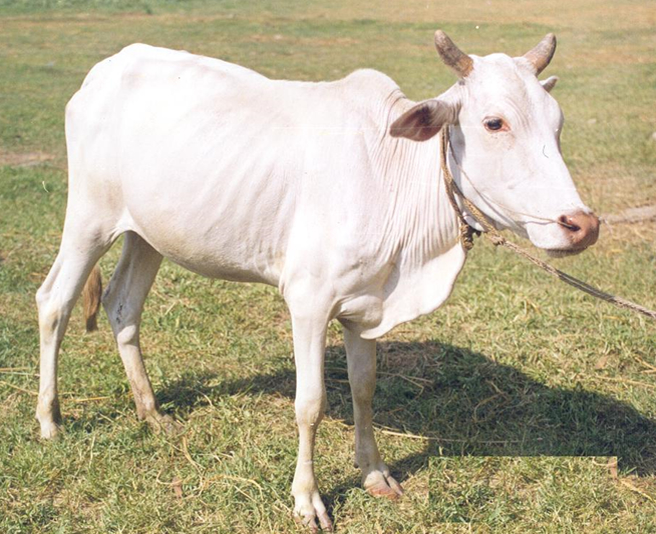
Bull
 Bachaur cattle are now concentrated in the areas adjoining Nepal border comprising Bachaur and Koilpur sub-divisions of Sitamarhi district.
Bachaur cattle are now concentrated in the areas adjoining Nepal border comprising Bachaur and Koilpur sub-divisions of Sitamarhi district.
 White or Grey in colour.
White or Grey in colour.
 Maintained by Koir and Ahir communities. Cattle are grazed in the nearby grassland area. Cows having male calves are not milked at all and the calf is allowed to take all the milk. Males are castrated at the time of eruption of horns. The males are traded everyday in small Hatia. Mustard sown with high seed rate is gradually thinned and used as green fodder.
Maintained by Koir and Ahir communities. Cattle are grazed in the nearby grassland area. Cows having male calves are not milked at all and the calf is allowed to take all the milk. Males are castrated at the time of eruption of horns. The males are traded everyday in small Hatia. Mustard sown with high seed rate is gradually thinned and used as green fodder.
 Known for draught qualities and ability to thrive on poor fodder resources.
Known for draught qualities and ability to thrive on poor fodder resources.
- BADRI ( Pahadi )
-
ORIGIN : Uttarakhand
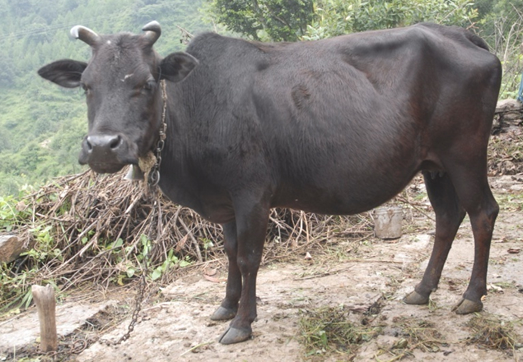
Cow

Bull
 Found in the hilly regions of Uttarakhand
Found in the hilly regions of Uttarakhand
 Well adapted to hilly terrains and climatic conditions. Balanced gait while walking.
Well adapted to hilly terrains and climatic conditions. Balanced gait while walking.
 Black, Brown, or Grey. Some of the females are also white in colour
Black, Brown, or Grey. Some of the females are also white in colour
 Small sized, active and sure-footed. Straight forehead with prominent poll, medium to large hump. Udder small and tucked up with the body.
Small sized, active and sure-footed. Straight forehead with prominent poll, medium to large hump. Udder small and tucked up with the body.
 These are indigenous cattle available in hilly areas of Uttarakhand. Badri cattle are small in size having long legs and varied body colours – black, brown, red, white or grey. Hooves and muzzle are black or brown in colour. Hump prominent. Udder is small in size, tucked up with the body. These are well adapted to the hilly terrain and climatic conditions and comparatively more resistant to diseases.
These are indigenous cattle available in hilly areas of Uttarakhand. Badri cattle are small in size having long legs and varied body colours – black, brown, red, white or grey. Hooves and muzzle are black or brown in colour. Hump prominent. Udder is small in size, tucked up with the body. These are well adapted to the hilly terrain and climatic conditions and comparatively more resistant to diseases.
- AMRUT MAHAL ( Benne Chawdi /Doddadana/Jawari Dana/Number Dana/ Arvin East breed )
-
ORIGIN : Chikmagalur, Chitradurga, Hassan, Shimoga, Tumkur and Davanagere districts of Karnataka.
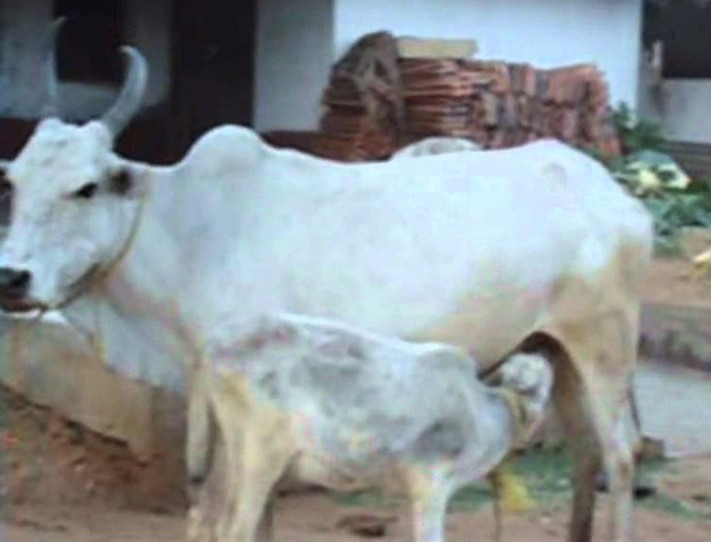
Cow
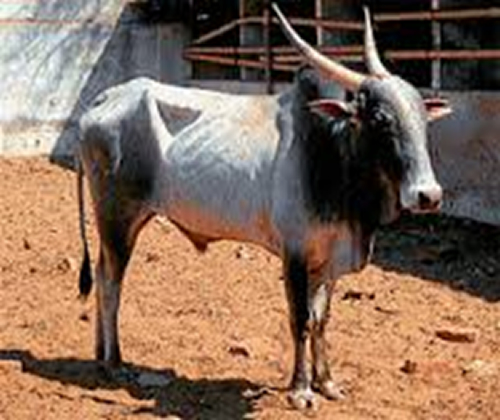
Bull
 The breed is usually Grey in colour but the colour varies from white to almost black. White grey markings are present on face and dewlap in some animals. Dark shades on neck, shoulder, hump and hindquarters. Head is long and tapers towards muzzle
The breed is usually Grey in colour but the colour varies from white to almost black. White grey markings are present on face and dewlap in some animals. Dark shades on neck, shoulder, hump and hindquarters. Head is long and tapers towards muzzle
 This is a famous draught breed known for its power and endurance and animals are fiery and active.
This is a famous draught breed known for its power and endurance and animals are fiery and active.
 The Amrithmahal literally means Milk and Mahal represented the office which manages Wild Cattle of the Royal Palace.
The Amrithmahal literally means Milk and Mahal represented the office which manages Wild Cattle of the Royal Palace.
- BELAHI ( Morni )
-
ORIGIN : Haryana/Chandigarh
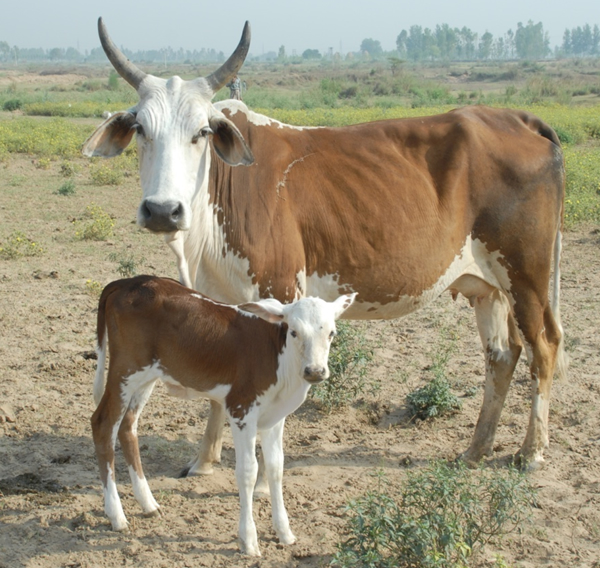
Cow
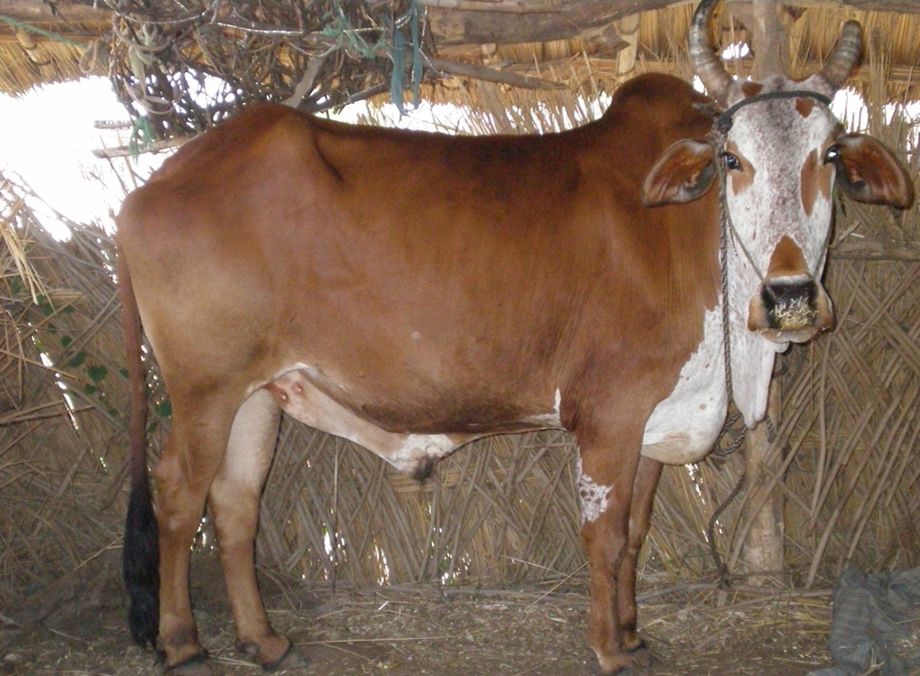
Bull
 Breeding tract lies in the foothills of Shivalik in Haryana
Breeding tract lies in the foothills of Shivalik in Haryana
 Gujjars known as Langarias, are maintaining the breed for generations
Gujjars known as Langarias, are maintaining the breed for generations
 Local cattle named on body colour pattern. Term ‘Belaha’ is used to describe mixture of colours
Local cattle named on body colour pattern. Term ‘Belaha’ is used to describe mixture of colours
 Belahi animals are migratory in nature and are maintained on low input cost. Migration starts in February - March and ends in October – November, every year.
Belahi animals are migratory in nature and are maintained on low input cost. Migration starts in February - March and ends in October – November, every year.
 Reddish Brown & Grey or white
Reddish Brown & Grey or white
 Medium sized animals. Uniform but distinct body colour pattern having reddish brown body, and white face and extremities and different degrees of white colour on ventral part of body. Head is straight and broad with prominent poll.
Medium sized animals. Uniform but distinct body colour pattern having reddish brown body, and white face and extremities and different degrees of white colour on ventral part of body. Head is straight and broad with prominent poll.
 Medium sized animals. Uniform but distinct body colour pattern having reddish brown body, and white face and extremities and different degrees of white colour on ventral part of body. Head is straight and broad with prominent poll.
Medium sized animals. Uniform but distinct body colour pattern having reddish brown body, and white face and extremities and different degrees of white colour on ventral part of body. Head is straight and broad with prominent poll.
- BINJHARPURI
-
ORIGIN : ODISHA
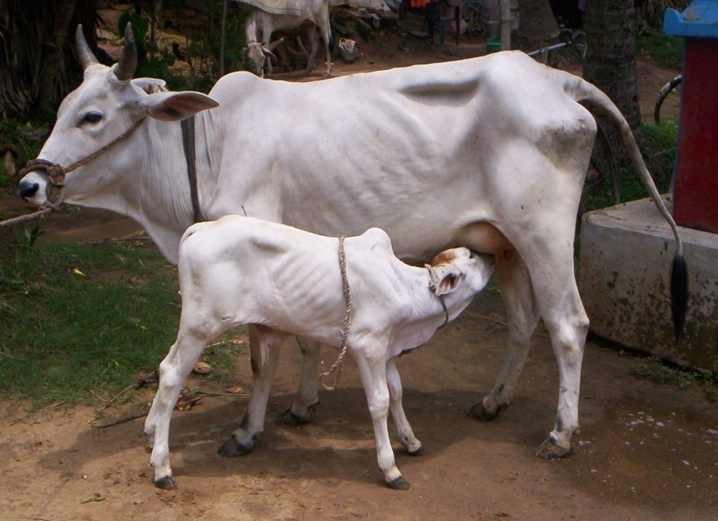
Cow
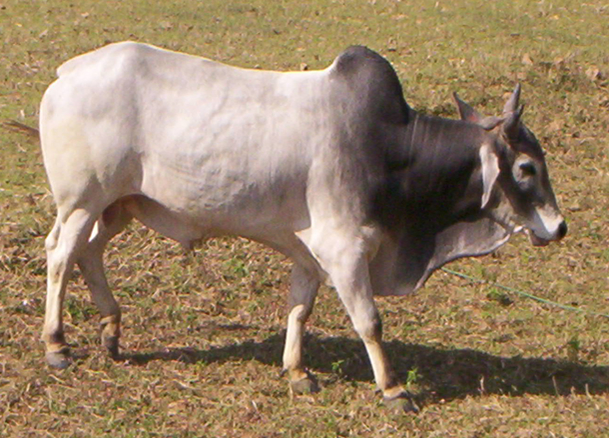
Bull
 Whole Jajpur district and adjoining areas of Kendrapara and Bhadrak. Heavy concentration is in Bari, Binjharpur and Dasrathapur area of Jajpur district
Whole Jajpur district and adjoining areas of Kendrapara and Bhadrak. Heavy concentration is in Bari, Binjharpur and Dasrathapur area of Jajpur district
 Named after the local area "Binjharpur" of Jajpur district in Orissa
White. Some animals are Grey, Black or Brown in colour
Medium sized, strong dual type animal. Hump, neck, and some region of face and back are black in colour irrespective of coat colour in males
Named after the local area "Binjharpur" of Jajpur district in Orissa
White. Some animals are Grey, Black or Brown in colour
Medium sized, strong dual type animal. Hump, neck, and some region of face and back are black in colour irrespective of coat colour in males
 Rice bran, water and paddy straw is provided to the animals in the morning before the animals are let loose for grazing. Working bullocks are fed with Kurchi- a mixture of rice bran, wheat bran, kitchen waste and some quantity of rice warmed with water
Rice bran, water and paddy straw is provided to the animals in the morning before the animals are let loose for grazing. Working bullocks are fed with Kurchi- a mixture of rice bran, wheat bran, kitchen waste and some quantity of rice warmed with water
- DANGI ( Kannadi )
-
ORIGIN : Gujarat / Maharashtra

Cow

Bull
 Mostly found in the Akola taluka of Ahmadnagar district, Sinner and Igatpuri taluka of Nashik districts of Maharashtra and Dangs district of Gujarat. It is also found near by Thane district of Maharashtra. Generally these animals are found near the hilly tract where forest is available in the ranges of Sahyadri.
Mostly found in the Akola taluka of Ahmadnagar district, Sinner and Igatpuri taluka of Nashik districts of Maharashtra and Dangs district of Gujarat. It is also found near by Thane district of Maharashtra. Generally these animals are found near the hilly tract where forest is available in the ranges of Sahyadri.
 Dangi cattle are extensively used for ploughing, harrowing and other field operations, and also for carting timber from forest area. The breed is well known for its excellent working qualities in heavy rainfall areas, rice fields and hilly tracts.
Dangi cattle are extensively used for ploughing, harrowing and other field operations, and also for carting timber from forest area. The breed is well known for its excellent working qualities in heavy rainfall areas, rice fields and hilly tracts.
 In Marathi Dang means mountains and these animals are living in mountains. Hence these are called Dangi. Some believe that this originates from the Dangs district in Gujarat.The synonym name Kandadi suggests the origin of the breed from Karnataka.
In Marathi Dang means mountains and these animals are living in mountains. Hence these are called Dangi. Some believe that this originates from the Dangs district in Gujarat.The synonym name Kandadi suggests the origin of the breed from Karnataka.
 The animals are adapted to hevy rainfall conditions. The skin exudes an oily secretion which protects from heavy rain.
The animals are adapted to hevy rainfall conditions. The skin exudes an oily secretion which protects from heavy rain.
 Dangi cattle have distinct white coat colour with red or black spots distributed unevenly over the body.
Dangi cattle have distinct white coat colour with red or black spots distributed unevenly over the body.
 Uneven distribution of black or red spots over the body. Forehead is slightly protruding.
Uneven distribution of black or red spots over the body. Forehead is slightly protruding.
 Dangi animals are hardy and subsist mostly on grazing alone. Dangi breeders are semi nomadic. They belong to Kanadi, Mahadeo Koli, Konkana, Thakar and Maratha communities, who practices seasonal migration and remain away from their villages for about 9 months in a year. During the hot dry season, the breeders migrate torwards coastal areas where grass, tree fodder and water are available to some extent.During the heavy rainfall, they settle down at the foot hills for protection from the cold draught.
Dangi animals are hardy and subsist mostly on grazing alone. Dangi breeders are semi nomadic. They belong to Kanadi, Mahadeo Koli, Konkana, Thakar and Maratha communities, who practices seasonal migration and remain away from their villages for about 9 months in a year. During the hot dry season, the breeders migrate torwards coastal areas where grass, tree fodder and water are available to some extent.During the heavy rainfall, they settle down at the foot hills for protection from the cold draught.
- GANGATIRI ( Eastern Hariana or Shahabadi )
-
ORIGIN : Bihar / Uttar Pradesh

Cow
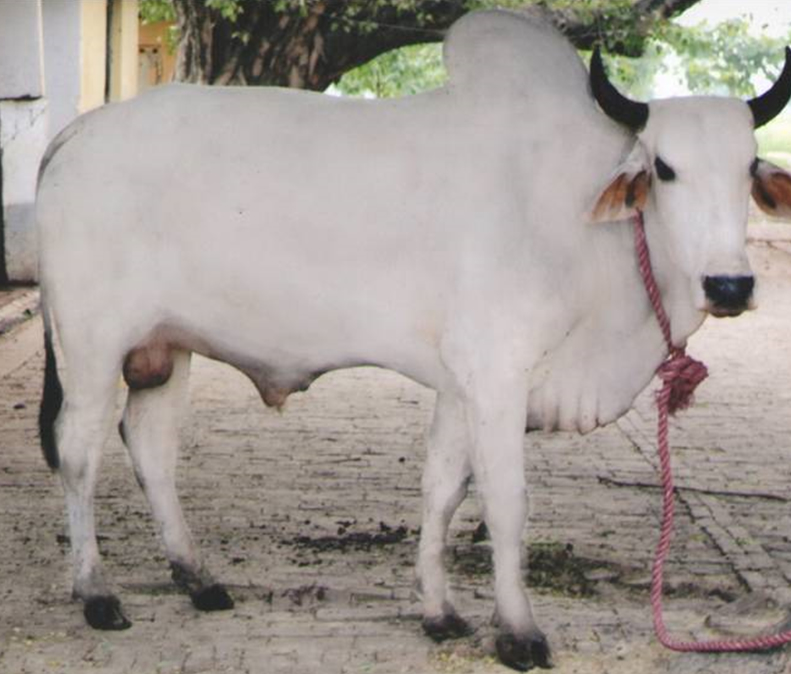
Bull
 Derived the name from its habitat, in the area nearby river Ganga
Derived the name from its habitat, in the area nearby river Ganga
 Medium milk producer.
Medium milk producer.
 Complete white (Dhawar), Grey (Sokan) and possess good draftability
Complete white (Dhawar), Grey (Sokan) and possess good draftability
 Forehead is Prominent, straight and broad with shallow groove in the middle. Eyelids, muzzle, hooves and tail switch are generally black
Forehead is Prominent, straight and broad with shallow groove in the middle. Eyelids, muzzle, hooves and tail switch are generally black
 Developed mostly by small and marginal farmers of several communities like Yadav, Bhumihar, Brahmin, Rajbhar, Kshatriya, Patel, etc
Developed mostly by small and marginal farmers of several communities like Yadav, Bhumihar, Brahmin, Rajbhar, Kshatriya, Patel, etc
- GAOLAO ( Arvi, Gaulgani )
-
ORIGIN : Maharashtra / Madhya Pradesh
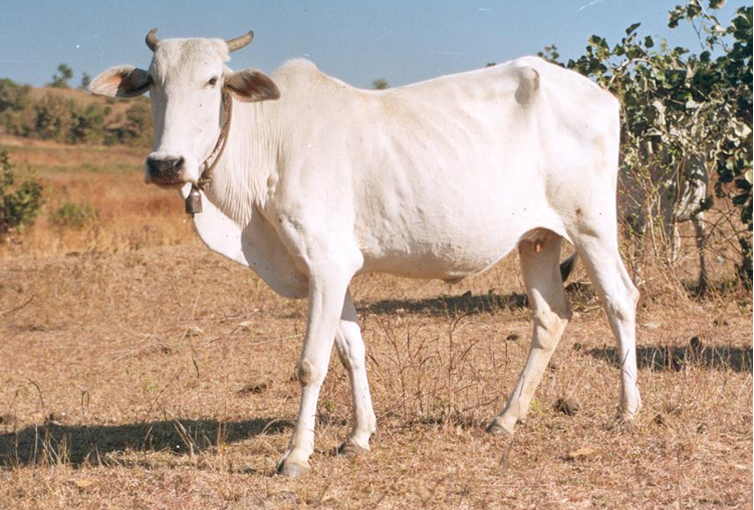
Cow
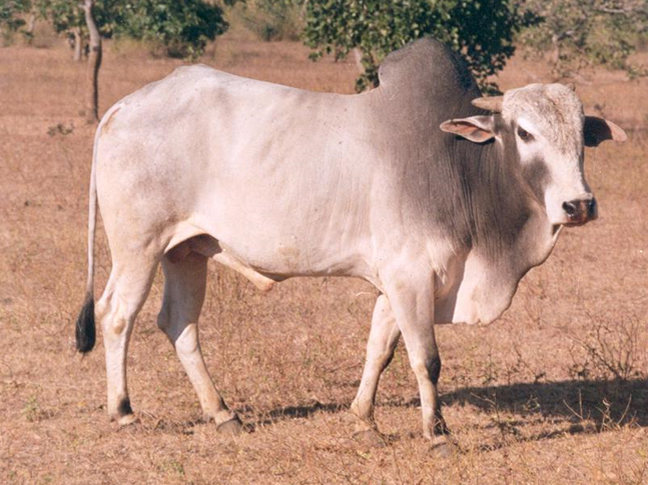
Bull
 This is a fast trotting type breed suitable for quick transportation in hilly areas.
This is a fast trotting type breed suitable for quick transportation in hilly areas.
 it resembles Ongole very much except that it is much lighter and has greater agility. Nanda Gawali community has developed this breed.
it resembles Ongole very much except that it is much lighter and has greater agility. Nanda Gawali community has developed this breed.
 Blackish white in males and White in female. Males are generally grey over the neck.
Blackish white in males and White in female. Males are generally grey over the neck.
 Head markedly long and narrow tapering towards muzzle. Forehead recedes at the top giving a slightly convex appearance. Eyes almond shaped and placed slightly at angles.
Head markedly long and narrow tapering towards muzzle. Forehead recedes at the top giving a slightly convex appearance. Eyes almond shaped and placed slightly at angles.
 Animals are grazed in grasslands preserved by the forest department. Grazing is usually available from middle of July to end of October. Sorghum is the principal crop of the area. Cows and young stock are usually under-nourished but bullocks and young male calves ready for sale are well fed. Bullocks are particularly trained to run fast.
Animals are grazed in grasslands preserved by the forest department. Grazing is usually available from middle of July to end of October. Sorghum is the principal crop of the area. Cows and young stock are usually under-nourished but bullocks and young male calves ready for sale are well fed. Bullocks are particularly trained to run fast.
- GHUMUSARI
-
ORIGIN : ODISHA
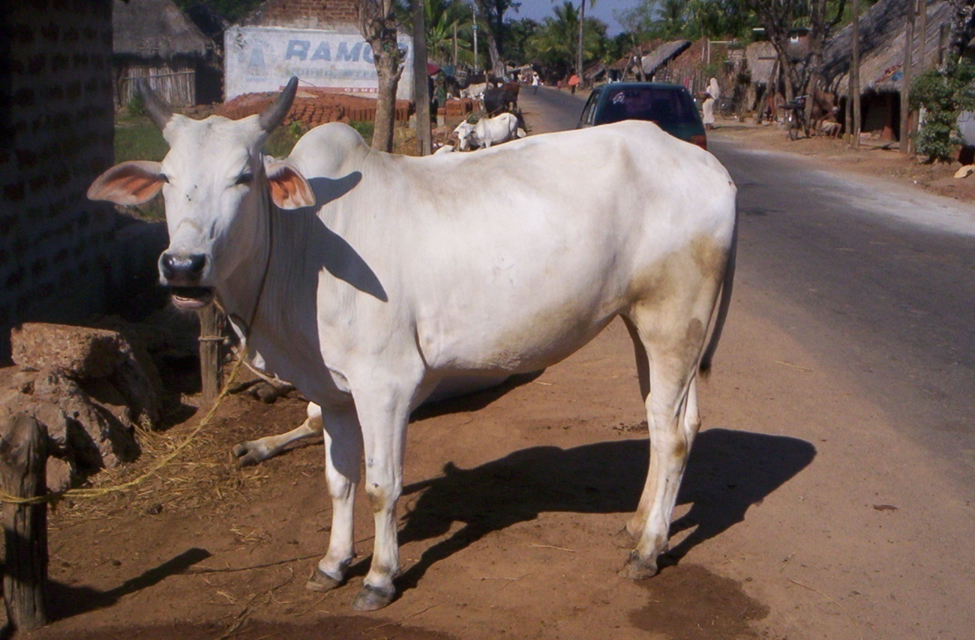
Cow
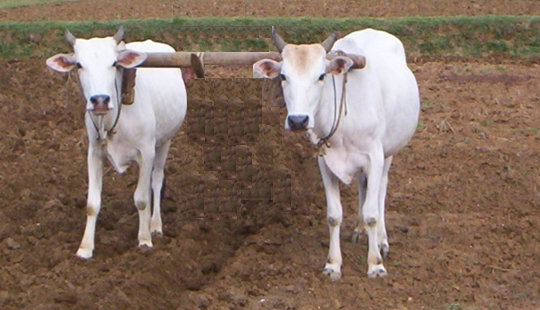
Bull
 Western part of Ganjam district and adjoining areas of Phulbani district. Heavy concentration is in Bhanjanagar, Sorada and Aska area of Ganjam district
named after the local area "Ghumusar" of Ganjam and Phulbani districts of Orissa
Western part of Ganjam district and adjoining areas of Phulbani district. Heavy concentration is in Bhanjanagar, Sorada and Aska area of Ganjam district
named after the local area "Ghumusar" of Ganjam and Phulbani districts of Orissa
 Mainly White sometimes Grey Small sized, strong and draft type animal. Small head with forehead being flat, broad and depressed in between the eyes
Mainly White sometimes Grey Small sized, strong and draft type animal. Small head with forehead being flat, broad and depressed in between the eyes
- HALLIKAR ( Mysore )
-
ORIGIN : Karnataka
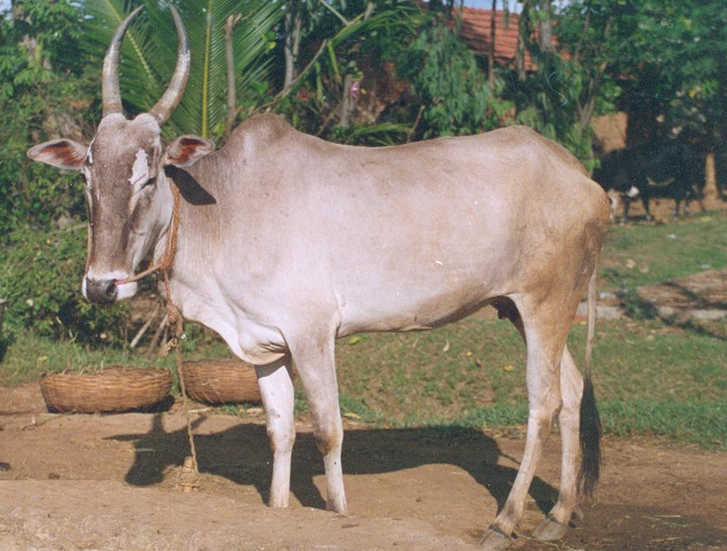
Cow
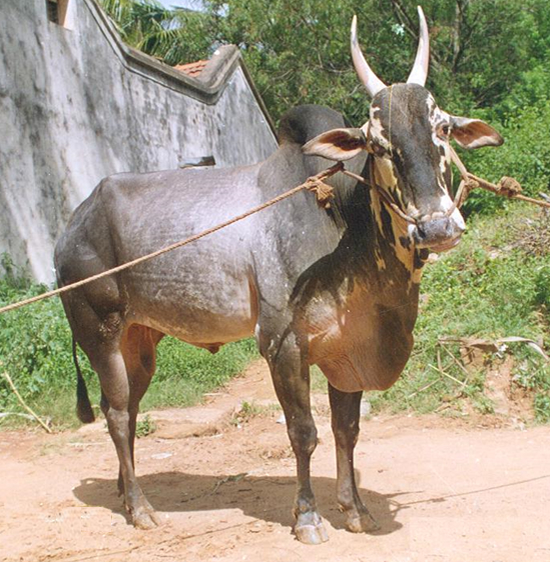
Bull
 The Hallikar breed of cattle is distributed in almost all the districts of south Karnataka and is also found in adjoining areas of Andhra Pradesh and Tamilnadu states.
The Hallikar breed of cattle is distributed in almost all the districts of south Karnataka and is also found in adjoining areas of Andhra Pradesh and Tamilnadu states.
 Best draught breed of Southern India.Most of the South Indian breeds have originated from this breed.
Best draught breed of Southern India.Most of the South Indian breeds have originated from this breed.
 The name of the breed, Hallikar, has been derived from the name of sub tribe Hallikar of Golla community mainly responsible for rearing of the breed.
The name of the breed, Hallikar, has been derived from the name of sub tribe Hallikar of Golla community mainly responsible for rearing of the breed.
 White to light grey with darker shadings on shoulder and hind quarters, especially in young breeding bulls.
White to light grey with darker shadings on shoulder and hind quarters, especially in young breeding bulls.
 White markings or irregular patches round the eyes and cheeks, and neck or shoulder region are the distinctive features of this breed
White markings or irregular patches round the eyes and cheeks, and neck or shoulder region are the distinctive features of this breed
 Cattle are bred by professional breeders and cultivators. Few families maintain their own stud bull and also provide service to others for a nomial fee. Cows are generally milked and are also used for all kind of farm operations. Bullocks are given special attention . Mostly fingermillet, grass, sorghum or pearlmillet are offered as green fodder.
Cattle are bred by professional breeders and cultivators. Few families maintain their own stud bull and also provide service to others for a nomial fee. Cows are generally milked and are also used for all kind of farm operations. Bullocks are given special attention . Mostly fingermillet, grass, sorghum or pearlmillet are offered as green fodder.
- HARIANA ( Hansi )
-
ORIGIN : Haryana
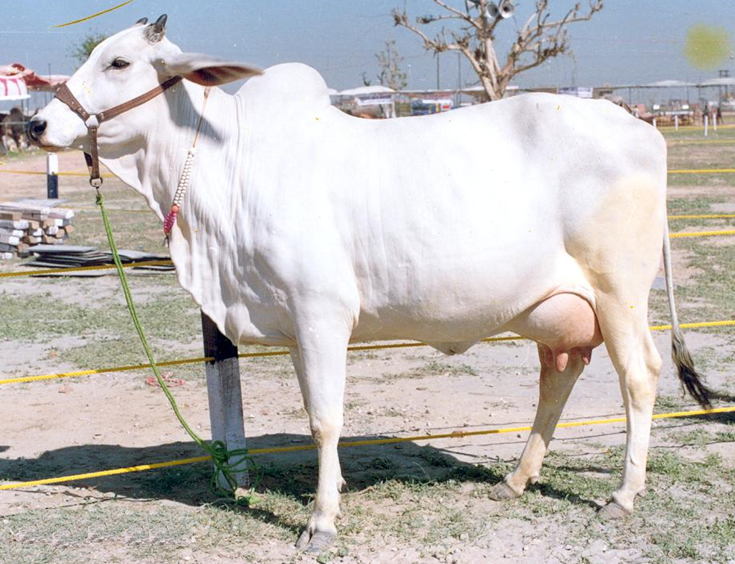
Cow
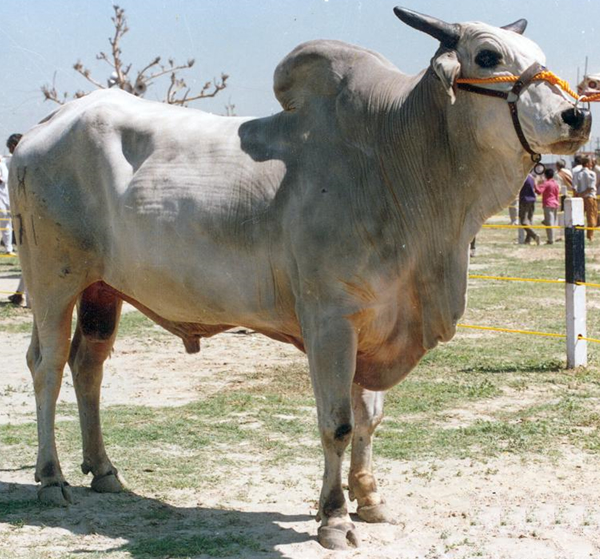
Bull
 Hariana is a prominent dual purpose breed of north India - widely spread in Indo Gangetic plains. It is primarily reared for bullock production . Cows are also fairly good milkers.
Hariana is a prominent dual purpose breed of north India - widely spread in Indo Gangetic plains. It is primarily reared for bullock production . Cows are also fairly good milkers.
 Hariana cattle take their name from the region known as Haryana in North India. There were two strains of cattle Hisar and Hansi found in this region and known after the name of their native towns. Hariana cattle seems to have originated from these two strains. Hisar and Hansi names do not exist now
Hariana cattle take their name from the region known as Haryana in North India. There were two strains of cattle Hisar and Hansi found in this region and known after the name of their native towns. Hariana cattle seems to have originated from these two strains. Hisar and Hansi names do not exist now
 Animals are white or light grey in colour. In bulls colour in between fore and hind quarters is relatively dark or dark grey.
Animals are white or light grey in colour. In bulls colour in between fore and hind quarters is relatively dark or dark grey.
 White colour, long and narow face, well marked bony prominence at the centre of poll and small horns.
White colour, long and narow face, well marked bony prominence at the centre of poll and small horns.
 Cattle are traditionally reared by grazing on common pasture land of the village and along the banks of cannals and roadsides with little supplementary feeding of crop residues, weeds and grasses. Calves are not weaned. Since Hariana cows are mainly reared for producing bullocks, greater attention is paid to rearing of male calves than of female calves. High yielding cows, bullocks and young males given green fodder and concentrate in addition to grazing . A.I. is the common method used to bred the animals. However, breeding bulls are also available in the village. Males are usually castrated at about 3 years of age.
Cattle are traditionally reared by grazing on common pasture land of the village and along the banks of cannals and roadsides with little supplementary feeding of crop residues, weeds and grasses. Calves are not weaned. Since Hariana cows are mainly reared for producing bullocks, greater attention is paid to rearing of male calves than of female calves. High yielding cows, bullocks and young males given green fodder and concentrate in addition to grazing . A.I. is the common method used to bred the animals. However, breeding bulls are also available in the village. Males are usually castrated at about 3 years of age.
- KANKREJ ( Wadad or Waged, Vagadia, Talabda, Nagar, Bonnai )
-
ORIGIN : Gujarat
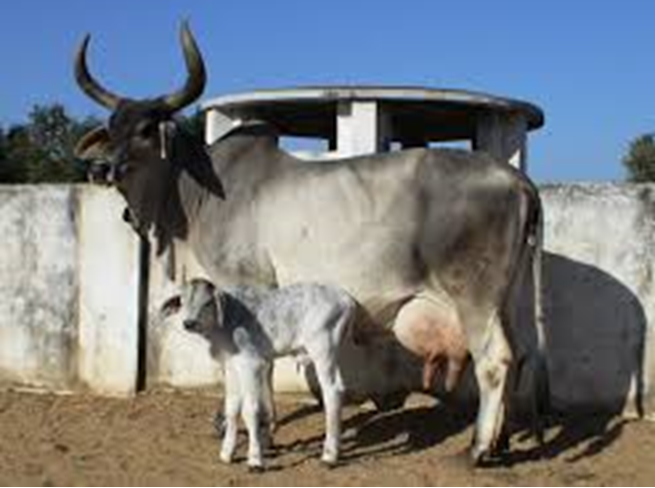
Cow
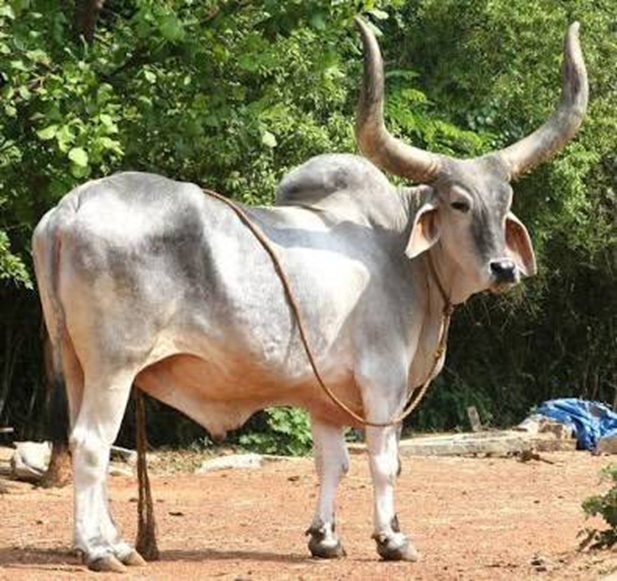
Bull
 It takes its name from the name of geographical area i.e. Kank taluka of Banaskantha district in Gujarat.
It takes its name from the name of geographical area i.e. Kank taluka of Banaskantha district in Gujarat.
 Varies from silver-grey to iron grey or steel grey. In males fore & hind quarters and hump are slightly darker than the rest of the body.
Varies from silver-grey to iron grey or steel grey. In males fore & hind quarters and hump are slightly darker than the rest of the body.
 Heaviest breed of cattle. Strong lyre shaped horns, large pendulsus and open ears.
Heaviest breed of cattle. Strong lyre shaped horns, large pendulsus and open ears.
 The Rabaris, Maldharis, Bharwads, Ahir and Charans are the main communities associated with breeding of the Kankrej. Animals are not tied. They are kept in paddocks of throny bushes near human dwellings. Animals are taken out for grazing. They cover long distances during scarcity periods. Calves are not weaned . Male calves are cared better than female calves. Castor, rapeseed and sesamum are common among the oilseeds. Clusterbeen seeds are used as cattle feed. Cotton seed and oil cake are used as concentrate.
The Rabaris, Maldharis, Bharwads, Ahir and Charans are the main communities associated with breeding of the Kankrej. Animals are not tied. They are kept in paddocks of throny bushes near human dwellings. Animals are taken out for grazing. They cover long distances during scarcity periods. Calves are not weaned . Male calves are cared better than female calves. Castor, rapeseed and sesamum are common among the oilseeds. Clusterbeen seeds are used as cattle feed. Cotton seed and oil cake are used as concentrate.
 The gait of the Kankrej is peculiar to the breed; the action is smooth, there is hardly any movement of the body, the head is held noticeably high, the stride is long and even and the hind hoof is placed well ahead of the impression of fore hoof. This gait is called 1¼ paces (Swai chal) by the breeders.
The gait of the Kankrej is peculiar to the breed; the action is smooth, there is hardly any movement of the body, the head is held noticeably high, the stride is long and even and the hind hoof is placed well ahead of the impression of fore hoof. This gait is called 1¼ paces (Swai chal) by the breeders.
- KENKATHA ( Kenwaria )
-
ORIGIN : MADHYA PRADESH / UTTAR PRADESH
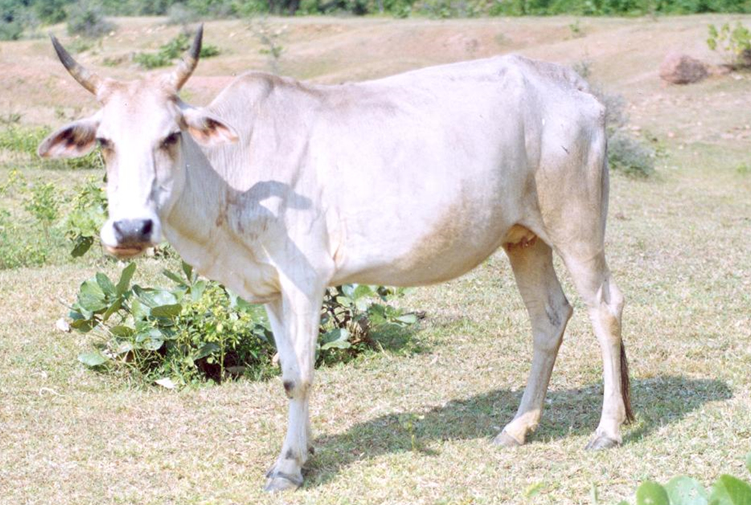
Cow
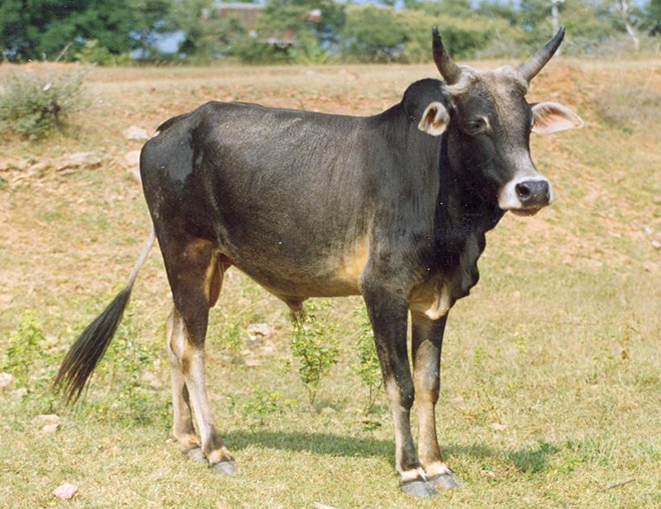
Bull
 The Kenkantha cattle take their name from the river Ken as they are bred along the banks of this river in the area of Bundelkhand.
The Kenkantha cattle take their name from the river Ken as they are bred along the banks of this river in the area of Bundelkhand.
 They have strong feet and well adapted to the agro-climatic conditions of Bundelkhand region.
They have strong feet and well adapted to the agro-climatic conditions of Bundelkhand region.
 Colour varies from grey on the barrel to dark grey on the rest of body.
Colour varies from grey on the barrel to dark grey on the rest of body.
 Small, sturdy and fairly powerful animal. Horns directed forwards.
Small, sturdy and fairly powerful animal. Horns directed forwards.
 Animals have to cover long distances in search of grazing pastures. Straws and husks from crops are utilized as cattle feed. Only few animals are maintained by each cultivator. Cows and young stock are maintained on grazing only. Pasture is scanty and generally consists of coarse grasses of cow nutritive value. Bullocks are usually fed good quality straws. All the animals of a village are taken for grazing by villagers turn by turn.
Animals have to cover long distances in search of grazing pastures. Straws and husks from crops are utilized as cattle feed. Only few animals are maintained by each cultivator. Cows and young stock are maintained on grazing only. Pasture is scanty and generally consists of coarse grasses of cow nutritive value. Bullocks are usually fed good quality straws. All the animals of a village are taken for grazing by villagers turn by turn.
 They thrive on poor feed and fodder resources.
They thrive on poor feed and fodder resources.
- KHARIAR
-
ORIGIN : ODISHA
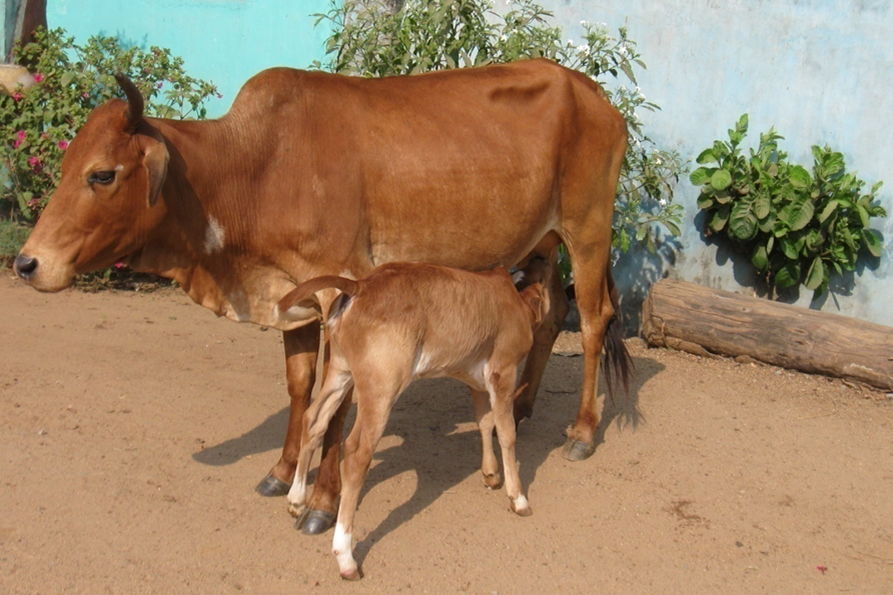
Cow
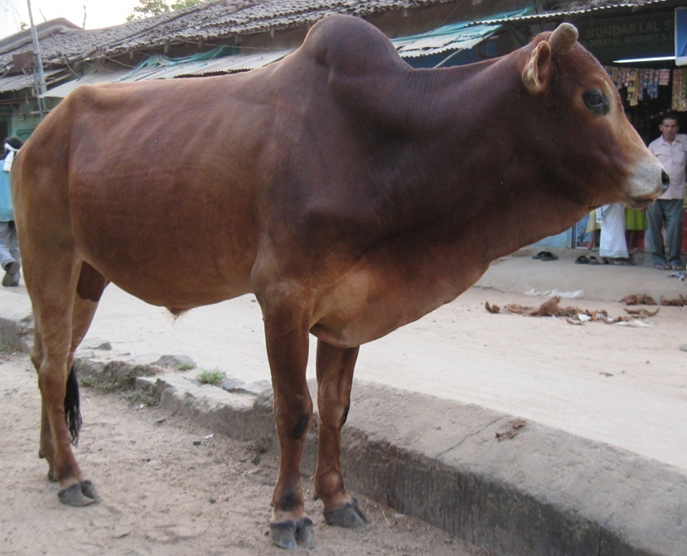
Bull
 Nuapada district and adjoining area in Kalahandi and Balangir district. Heavy concentration is in Khariar, Komna, Sinapali and Boden blocks of Nuapada district named after the its native tract "Khariar" in Nuapada district of Orissa
Nuapada district and adjoining area in Kalahandi and Balangir district. Heavy concentration is in Khariar, Komna, Sinapali and Boden blocks of Nuapada district named after the its native tract "Khariar" in Nuapada district of Orissa
 Used for draft power in its native tract which is hilly and undulated
Used for draft power in its native tract which is hilly and undulated
 Mainly Brown sometimes Grey
Mainly Brown sometimes Grey
 Small sized, strong draft type animal. Hump, neck, and some region of face and back are dark in colour
Small sized, strong draft type animal. Hump, neck, and some region of face and back are dark in colour
 Cattle of entire village or hamlet are taken together for grazing by one or two persons during cropping season to avoid damage to crops. Animals often go on their own for grazing during post harvest period
Cattle of entire village or hamlet are taken together for grazing by one or two persons during cropping season to avoid damage to crops. Animals often go on their own for grazing during post harvest period
- KHERIGARH ( Kheri, Kharigarh, Khari )
-
ORIGIN : UTTAR PRADESH
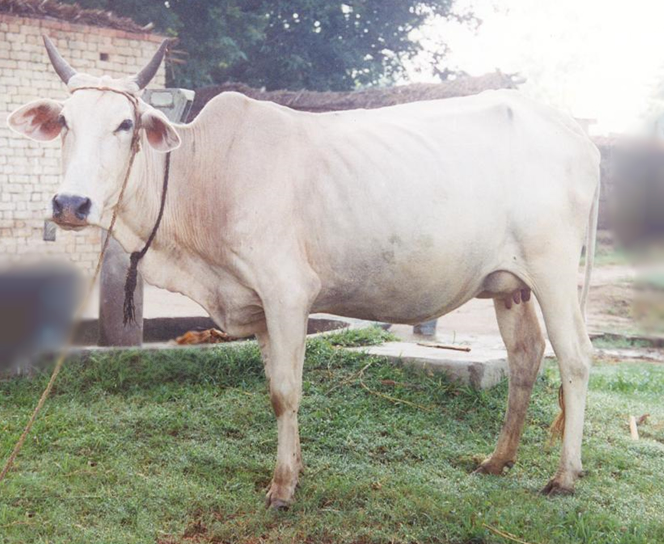
Cow
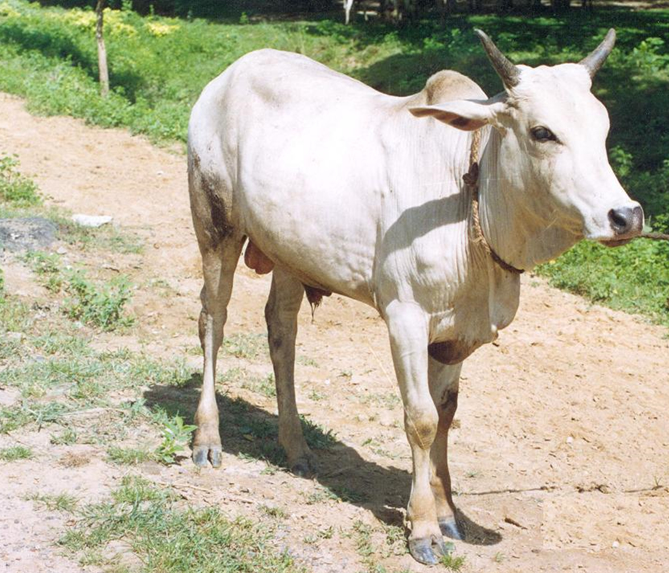
Bull
 Some animals are also found in adjoining Pilibhit district.
Some animals are also found in adjoining Pilibhit district.
 Bullocks are very good for draught purposes. They run very fast.
Bullocks are very good for draught purposes. They run very fast.
 This breed has been named after the name of area.
This breed has been named after the name of area.
 Animals have white coat colour. Some animals have grey colour distributed all over body espeically on face.
Animals have white coat colour. Some animals have grey colour distributed all over body espeically on face.
 Small but active animal.
Small but active animal.
 The region has an abundance of coarse grasses and most of the animals are maintained on grazing only. No additional fodder or concentrate is provided. Housing is also not provided. They are tied in the open area. Males are castrated at about 42 months of age and used for work. Calves are reared mostly on milk. In some cases cow is not milked at all.
The region has an abundance of coarse grasses and most of the animals are maintained on grazing only. No additional fodder or concentrate is provided. Housing is also not provided. They are tied in the open area. Males are castrated at about 42 months of age and used for work. Calves are reared mostly on milk. In some cases cow is not milked at all.
 Animals are resistant to diseases and the expenditure on treatment is almost nil.
Animals are resistant to diseases and the expenditure on treatment is almost nil.
- KHILLAR ( Mandeshi, Shikari, Thillar )
-
ORIGIN : Karnataka / Maharashtra
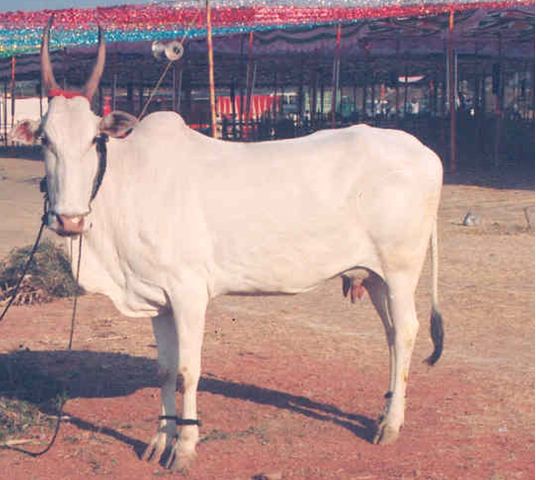
Cow

Bull
 Originated from Hallikar or Amritmahal breed of cattle. Khillari means herd of cattle and herdman is known as Khillari or Thillari. Four types of Khillari are prevalent in different parts. Atpadi Mahal in Southern Maharashtra, Mhaswad in Solapur and Satara area, Thillari in Satpura range of hills, and Nakali in adjoining area of this region.
Originated from Hallikar or Amritmahal breed of cattle. Khillari means herd of cattle and herdman is known as Khillari or Thillari. Four types of Khillari are prevalent in different parts. Atpadi Mahal in Southern Maharashtra, Mhaswad in Solapur and Satara area, Thillari in Satpura range of hills, and Nakali in adjoining area of this region.
 Khillaris of Deccan plateau - the Mhaswad and the Atapadi Mahal type are greyis-white. Males are dark over the fore & hind quarters with peculiar grey and white mottled marking on face.The Tapti Khillariis are white with carroty nose and carroty hooves.
Khillaris of Deccan plateau - the Mhaswad and the Atapadi Mahal type are greyis-white. Males are dark over the fore & hind quarters with peculiar grey and white mottled marking on face.The Tapti Khillariis are white with carroty nose and carroty hooves.
 Bow shape, long horns. A distinct groove in the centre of forehead from the nasal bridge to the centre of the poll. Sharp and prominnent nasal bridge.
Bow shape, long horns. A distinct groove in the centre of forehead from the nasal bridge to the centre of the poll. Sharp and prominnent nasal bridge.
 Usually male calf is allowed to suck all the milk it can take until the dam goes dry. Cow is partially milked if it has a female calf. Males are castrated at about 5 to 5½ years of age. Sorghum and bajara are extensively grown in the area. Grains are used for human consumption while stalks are fed to cattle. Maize and some varieties of sorghum are also grown as fodder crops.
Usually male calf is allowed to suck all the milk it can take until the dam goes dry. Cow is partially milked if it has a female calf. Males are castrated at about 5 to 5½ years of age. Sorghum and bajara are extensively grown in the area. Grains are used for human consumption while stalks are fed to cattle. Maize and some varieties of sorghum are also grown as fodder crops.
 Bullocks are highly valued as fast powerfull draught animals. They can travel miles without showing any signs of fatigue. Cattle of this breed have been exported to North-Western Sri Lanka to improve the draught qualities of Sinhala breed.
Bullocks are highly valued as fast powerfull draught animals. They can travel miles without showing any signs of fatigue. Cattle of this breed have been exported to North-Western Sri Lanka to improve the draught qualities of Sinhala breed.
- KOSALI
-
ORIGIN : Chattisgarh
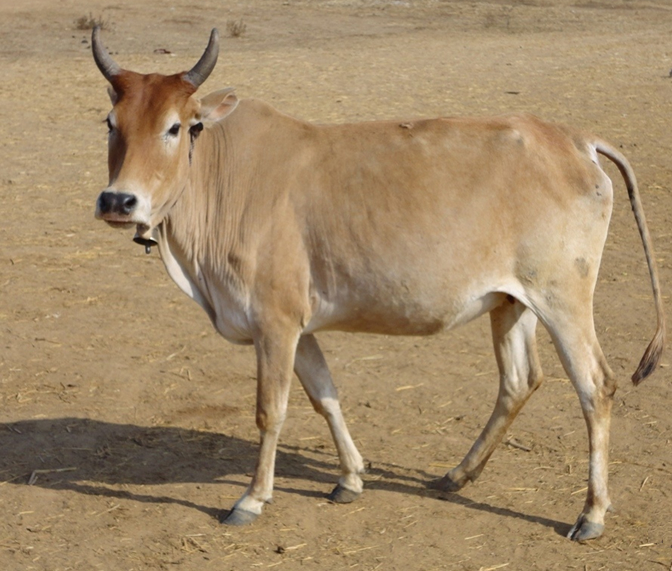
Cow
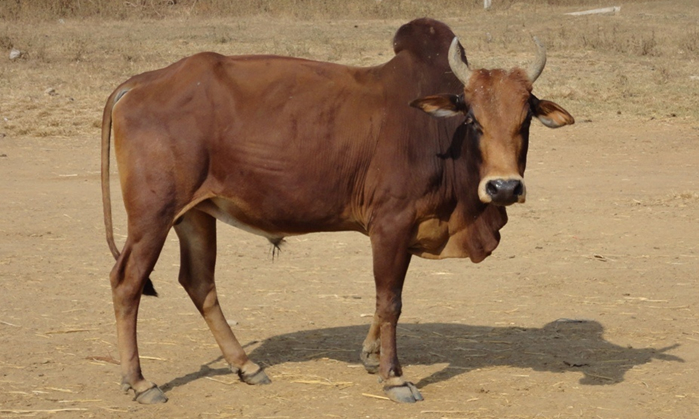
Bull
 Predominately seen in the plain area of Chhattisgarh. The ancient name of this region was ‘Kowshal’, named after the maternal uncle house of Lord Ram.Farmers particularly Yadava/Rawuth community are keeping this cattle generation after generation.
Predominately seen in the plain area of Chhattisgarh. The ancient name of this region was ‘Kowshal’, named after the maternal uncle house of Lord Ram.Farmers particularly Yadava/Rawuth community are keeping this cattle generation after generation.
 Mainly light red (60-65%), followed by whitish grey (30-35%). Few animals (3-5%) having black coat colour or red with white patches also seen
Mainly light red (60-65%), followed by whitish grey (30-35%). Few animals (3-5%) having black coat colour or red with white patches also seen
 Muzzle, eyelids, tail switch and hooves are black. Head broad, flat and straight. Hump small to medium in size. Udder small and bowl shaped.
Muzzle, eyelids, tail switch and hooves are black. Head broad, flat and straight. Hump small to medium in size. Udder small and bowl shaped.
 Most of the time local cows are let loose and meet their feed requirements through grazing. Besides grazing, paddy straw is also provided by the farmers. Some amount of concentrate is provided to lactating and advanced pregnant animals.
Most of the time local cows are let loose and meet their feed requirements through grazing. Besides grazing, paddy straw is also provided by the farmers. Some amount of concentrate is provided to lactating and advanced pregnant animals.
 Bullocks of this breed are very efficient for paddy field operation after sowing. This method is called ”Beeashi” in local language
Bullocks of this breed are very efficient for paddy field operation after sowing. This method is called ”Beeashi” in local language
- KRISHNA VALLEY
-
ORIGIN : Karnataka / Maharashtra
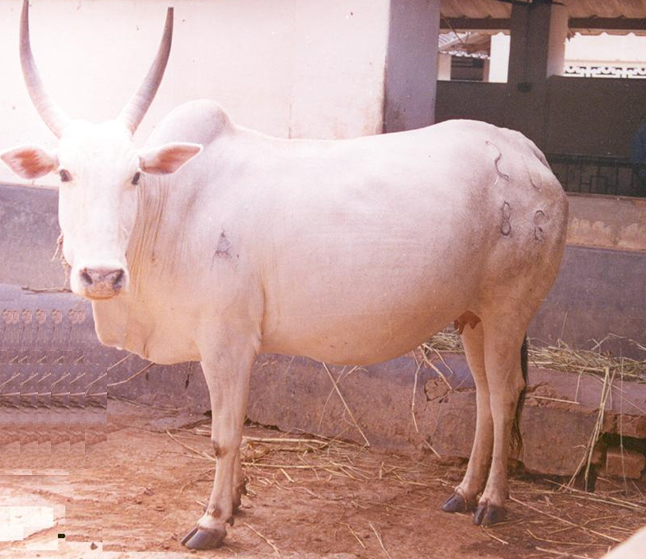
Cow
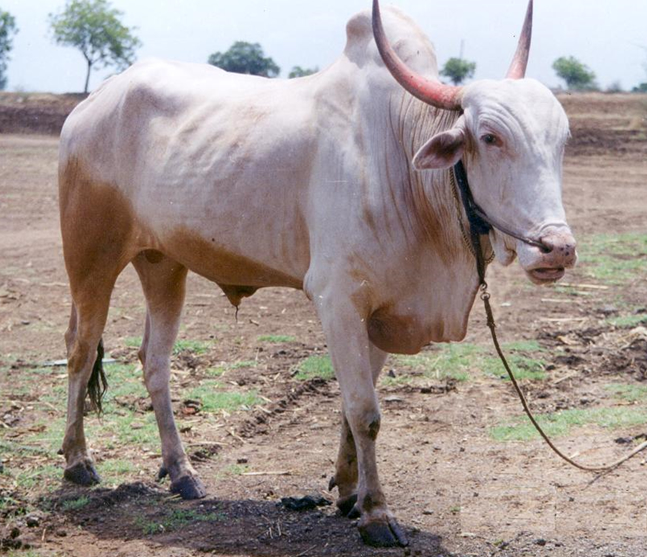
Bull
 This is a heavy draught breed and used exclusively in the black cotton soil of the watershed of river Krishna.
This is a heavy draught breed and used exclusively in the black cotton soil of the watershed of river Krishna.
 Gir cattle from Kathiawar, Ongole from Andhra Pradesh, Kankrej from Gujarat and local cattle having Mysore type blood in them have contributed to the origin of Krishna Valley breed.
Gir cattle from Kathiawar, Ongole from Andhra Pradesh, Kankrej from Gujarat and local cattle having Mysore type blood in them have contributed to the origin of Krishna Valley breed.
 The common colour is grey - white with a darker shade on fore & hind quarters in males. Adult females are more whitish in appearance. Brown & white, black & white, and mottled colours are often seen.
The common colour is grey - white with a darker shade on fore & hind quarters in males. Adult females are more whitish in appearance. Brown & white, black & white, and mottled colours are often seen.
 Massive body, distinct bulge in the forehead.
Massive body, distinct bulge in the forehead.
 Cattle are usually allowed to graze only after the grasses have been harvested for hay making. All animals are stall fed throughout the year. Sorghum, maize, beans and grasses are fed as green fodder. Concentrate is fed to milking cows and bullocks. Shevri is grown extensively along the banks of the rivers; the plant remains green throughout the summer. Loppings are used for feeding . Male calves are allowed to suck two teat and female calves one teat. At the age of 2-1/2 years, young males are broken into work, and at 3 to 4 years, they are castrated and sold as bullocks.
Cattle are usually allowed to graze only after the grasses have been harvested for hay making. All animals are stall fed throughout the year. Sorghum, maize, beans and grasses are fed as green fodder. Concentrate is fed to milking cows and bullocks. Shevri is grown extensively along the banks of the rivers; the plant remains green throughout the summer. Loppings are used for feeding . Male calves are allowed to suck two teat and female calves one teat. At the age of 2-1/2 years, young males are broken into work, and at 3 to 4 years, they are castrated and sold as bullocks.
 Bullocks of this breed have been exported to Brazil and the United States of America.
Bullocks of this breed have been exported to Brazil and the United States of America.
- MALNAD GIDDA ( Gidda, Uradana Varshagandhi )
-
ORIGIN : Karnataka
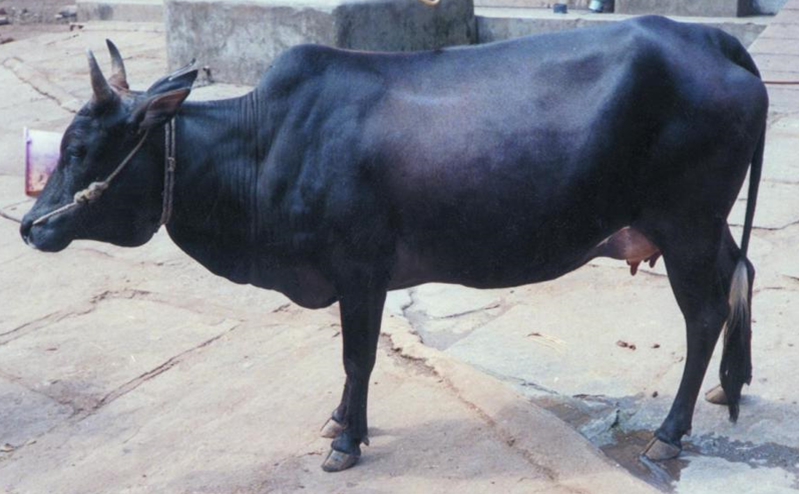
Cow
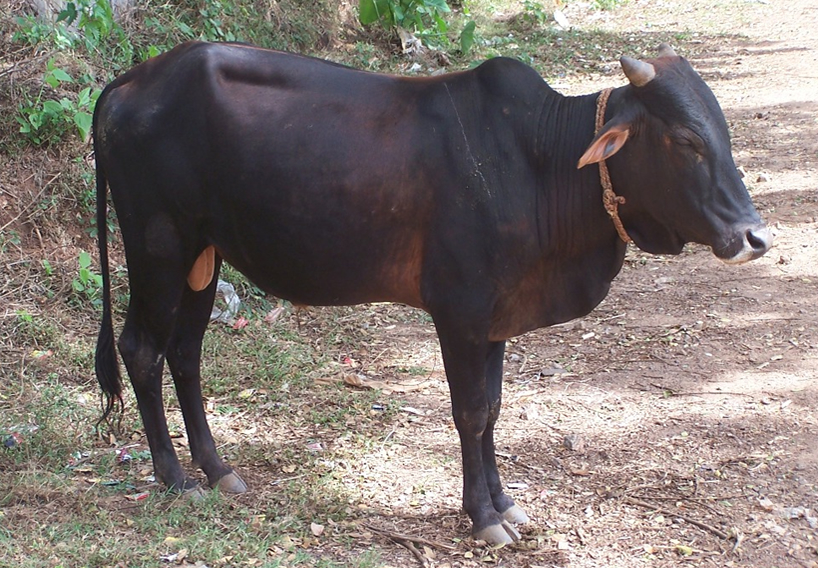
Bull
 They play a major role in the rural economy of this region by providing milk, manure and draft power with negligible inputs
They play a major role in the rural economy of this region by providing milk, manure and draft power with negligible inputs
 The word Gidda means dwarf and Malnad means a place receiving heavy rainfall, where these cattle are inhabited. Malay means hilly, Nadu means place (Malay+Nadu= Malnad) and gidda means small.
The word Gidda means dwarf and Malnad means a place receiving heavy rainfall, where these cattle are inhabited. Malay means hilly, Nadu means place (Malay+Nadu= Malnad) and gidda means small.
 They are well adapted to the local agro ecological systems of Western Ghats
They are well adapted to the local agro ecological systems of Western Ghats
 The predominant coat colour is black with light shades of fawn on thigh and shoulder region
The predominant coat colour is black with light shades of fawn on thigh and shoulder region
 They are small in size with compact body frame weighing around 80-120 Kg. Tail switch - black, hump - small, udder small and bowl shaped.
They are small in size with compact body frame weighing around 80-120 Kg. Tail switch - black, hump - small, udder small and bowl shaped.
 During nights animals are housed in traditional shed where in dung and urine is not cleared regularly. Green leaves are spread on the floor everyday as bedding material over the dung and urine. It is cleared once in one to two months which forms good quality compost manure normally. These animals are sent for grazing from morning till evening. They are also fed with small quantities of paddy straw, spear grass and green grass depending on availability. Generally they are bred by natural service when they go for grazing.
During nights animals are housed in traditional shed where in dung and urine is not cleared regularly. Green leaves are spread on the floor everyday as bedding material over the dung and urine. It is cleared once in one to two months which forms good quality compost manure normally. These animals are sent for grazing from morning till evening. They are also fed with small quantities of paddy straw, spear grass and green grass depending on availability. Generally they are bred by natural service when they go for grazing.
 Malnad Gidda cattle are reared under low input low output system. Some areas it is zero input system where animals sustain solely on grazing. Elite cows give 3-5 kg of milk per day despite small body size. These animals are highly adapted to harsh climatic conditions including heavy rainfall conditions. These animals run fast, jump high and long.
Malnad Gidda cattle are reared under low input low output system. Some areas it is zero input system where animals sustain solely on grazing. Elite cows give 3-5 kg of milk per day despite small body size. These animals are highly adapted to harsh climatic conditions including heavy rainfall conditions. These animals run fast, jump high and long.
- MALVI ( Mahadeo puri, Manthani )
-
ORIGIN : Madhya Pradesh
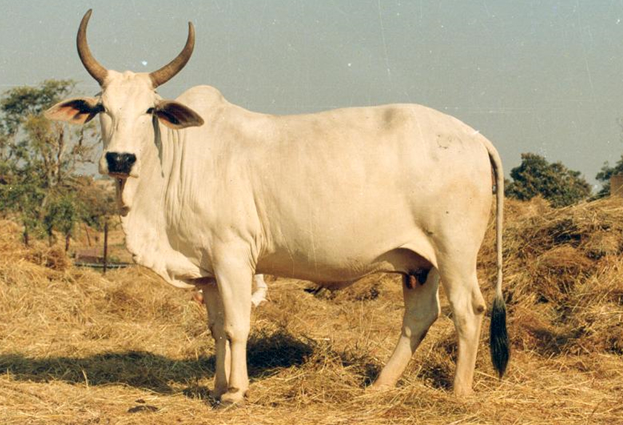
Cow
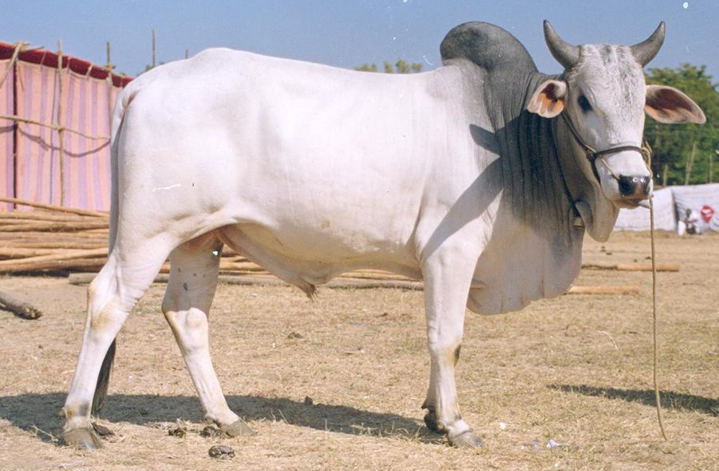
Bull
 Also found in Ratlam district and adjacent areas of Madhya Pradesh.
Also found in Ratlam district and adjacent areas of Madhya Pradesh.
 Well known for quick transportation, endurance and ability to carry heavy load on rough roads.
Well known for quick transportation, endurance and ability to carry heavy load on rough roads.
 Named after its place of origin viz. Malwa region
Named after its place of origin viz. Malwa region
 Malvi cattle are white or white greyish - darker in males, with neck, shoulders, hump and quarters almost black. Cows and bullocks become nearly pure white with age.
Malvi cattle are white or white greyish - darker in males, with neck, shoulders, hump and quarters almost black. Cows and bullocks become nearly pure white with age.
 Strong well built whitish grey animal with lyre shaped horns.
Strong well built whitish grey animal with lyre shaped horns.
 Plenty of grasses are available for grazing. Cattle owners take their cattle to grazing areas during day time and bring them back in evening. Sorghum and maize are grown as fodder crops.Concentrate is given only to bullocks.
Plenty of grasses are available for grazing. Cattle owners take their cattle to grazing areas during day time and bring them back in evening. Sorghum and maize are grown as fodder crops.Concentrate is given only to bullocks.
- MEWATI ( Kosi )
-
ORIGIN : Haryana / Rajasthan / Uttar Pradesh
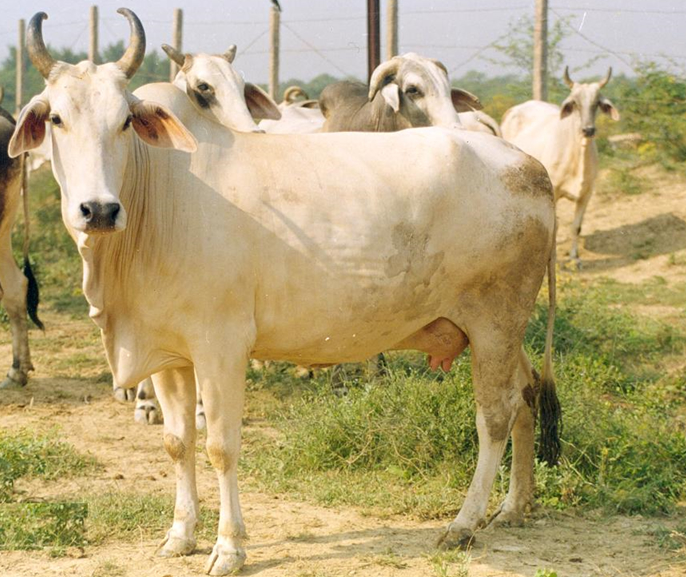
Cow
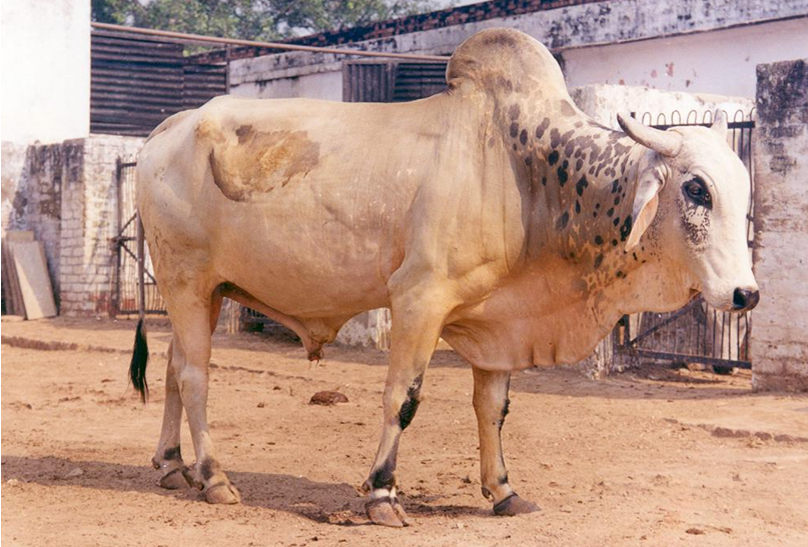
Bull
 Mewati cattle are powerful and docile, and are useful for heavy ploughing, carting and drawing water from deep wells.
Mewati cattle are powerful and docile, and are useful for heavy ploughing, carting and drawing water from deep wells.
 Similar to Hariana but there are traces of influence of Gir, Kankrej and Malvi breeds.
Similar to Hariana but there are traces of influence of Gir, Kankrej and Malvi breeds.
 Mewati cattle are usually white with neck, shoulders and quarters of a darker shade.
Mewati cattle are usually white with neck, shoulders and quarters of a darker shade.
 Face is long and narrow with straight, sometimes slightly bulging forehead.
Face is long and narrow with straight, sometimes slightly bulging forehead.
 Very little grazing is available for a limited period of two months, otherwise they are stall fed. Cattle depend mostly on the by-products of cereals, sorghum, millets, wheat, barley, chick peas etc. Concentrate such as oilcakes and crushed grains are given to bullocks only. Calves are not weaned. Male calves receive greater attention than female calves since the breed is basically reared for draught purpose.
Very little grazing is available for a limited period of two months, otherwise they are stall fed. Cattle depend mostly on the by-products of cereals, sorghum, millets, wheat, barley, chick peas etc. Concentrate such as oilcakes and crushed grains are given to bullocks only. Calves are not weaned. Male calves receive greater attention than female calves since the breed is basically reared for draught purpose.
- MOTU
-
ORIGIN : ODISHA
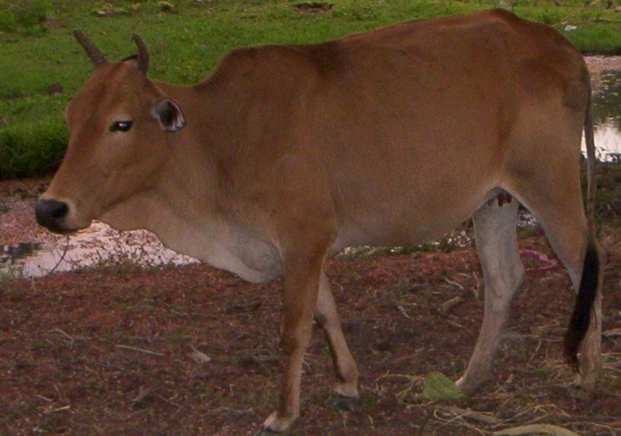
Cow
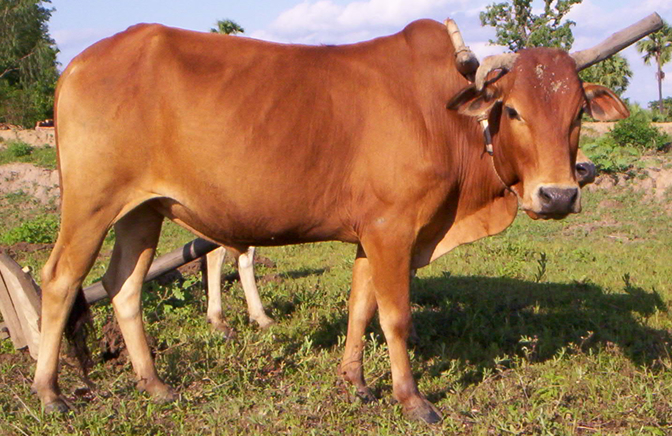
Bull
 Southern part of Malkangiri district and adjoining area of Chhattisgarh and Andhra Pradesh. Heavy concentration is in Motu, Kalimela, Podia and Malkangiri area of Malkangiri district in Orissa. Sandy and clay type soil is predominant. Most of the area is covered with forest.
Southern part of Malkangiri district and adjoining area of Chhattisgarh and Andhra Pradesh. Heavy concentration is in Motu, Kalimela, Podia and Malkangiri area of Malkangiri district in Orissa. Sandy and clay type soil is predominant. Most of the area is covered with forest.
 Named after local area "Motu" of Malkangiri district in Orissa
Named after local area "Motu" of Malkangiri district in Orissa
 These dwarf cattle used for draught power in hilly and undulated terrain
These dwarf cattle used for draught power in hilly and undulated terrain
 Mainly Brown (Reddish) sometimes Grey. Few animals are white in colour
Mainly Brown (Reddish) sometimes Grey. Few animals are white in colour
 Small sized, strong and draft type cattle. Animals are mostly polled and brown in colour
Small sized, strong and draft type cattle. Animals are mostly polled and brown in colour
 No supplementation of feed is given even in pregnancy or at calving. Group of animals are tied with a single rope both ends of which are tied to pillars
No supplementation of feed is given even in pregnancy or at calving. Group of animals are tied with a single rope both ends of which are tied to pillars
 Cow dung is considered as important product from rearing of these cattle among the Koya tribes.
Cow dung is considered as important product from rearing of these cattle among the Koya tribes.
- NAGORI
-
ORIGIN : Rajastahan
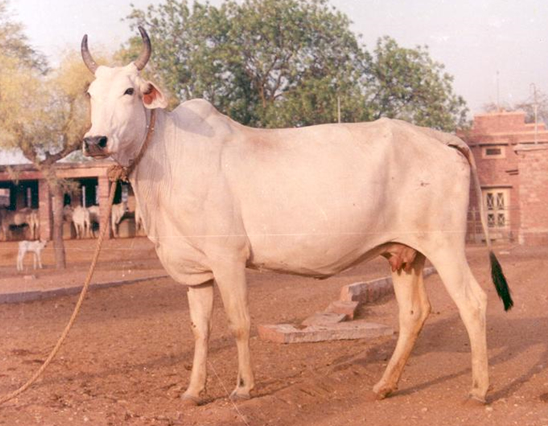
Cow
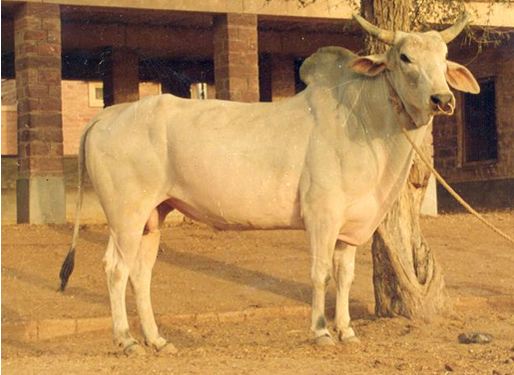
Bull
 Nagaur district but animals are also found in adjoining Jodhpur district and Nokha tehsil of Bikaner district.
Nagaur district but animals are also found in adjoining Jodhpur district and Nokha tehsil of Bikaner district.
 Nagori takes its name from its home tract i.e. Nagaur district of Rajasthan in Western India
Nagori takes its name from its home tract i.e. Nagaur district of Rajasthan in Western India
 Adapted to the harsh climatic conditions of Rajasthan
Adapted to the harsh climatic conditions of Rajasthan
 Generally white or light grey. In some cases head, face and shoulder are slightly greyish.
Generally white or light grey. In some cases head, face and shoulder are slightly greyish.
 White, upstanding, very alert and agile animal with long and narrow face like that of a horse.
White, upstanding, very alert and agile animal with long and narrow face like that of a horse.
 Animal feed resources including water are scarce. Main fodders available in the area are some trees like Khejri, Kabli keekar, Jal, Aakh and sewan grass. Animasl are taken out for grazing and they cover long distances in search of fodder. Bullocks are usually stall fed. Animals are kept in open areas fenced either by bushes or by small mud walls. During extreme weather conditions, a temporary shelter of thatched roof is provided. Calves are allowed to suck milk as long as their dams give milk. Male calves are cared better as compared to female calves. Males are castrated at about 6 months of age. Natural mating is practised.
Animal feed resources including water are scarce. Main fodders available in the area are some trees like Khejri, Kabli keekar, Jal, Aakh and sewan grass. Animasl are taken out for grazing and they cover long distances in search of fodder. Bullocks are usually stall fed. Animals are kept in open areas fenced either by bushes or by small mud walls. During extreme weather conditions, a temporary shelter of thatched roof is provided. Calves are allowed to suck milk as long as their dams give milk. Male calves are cared better as compared to female calves. Males are castrated at about 6 months of age. Natural mating is practised.
 Bullocks are big and powerful. They are capable of heavy draught work in deep sand.There is a tendency to legginess and lightness of bone, though feet are strong. This characteristic has given the breed its agility and case of movement. It turns like a horse.
Bullocks are big and powerful. They are capable of heavy draught work in deep sand.There is a tendency to legginess and lightness of bone, though feet are strong. This characteristic has given the breed its agility and case of movement. It turns like a horse.
- NIMARI ( Khargaon, Khargoni, Khurgoni )
-
ORIGIN : Madhya Pradesh
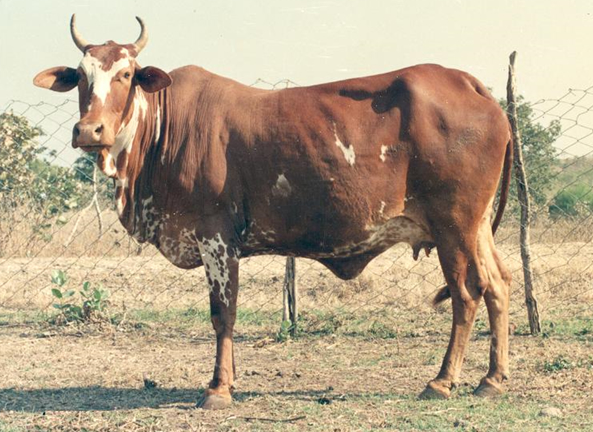
Cow
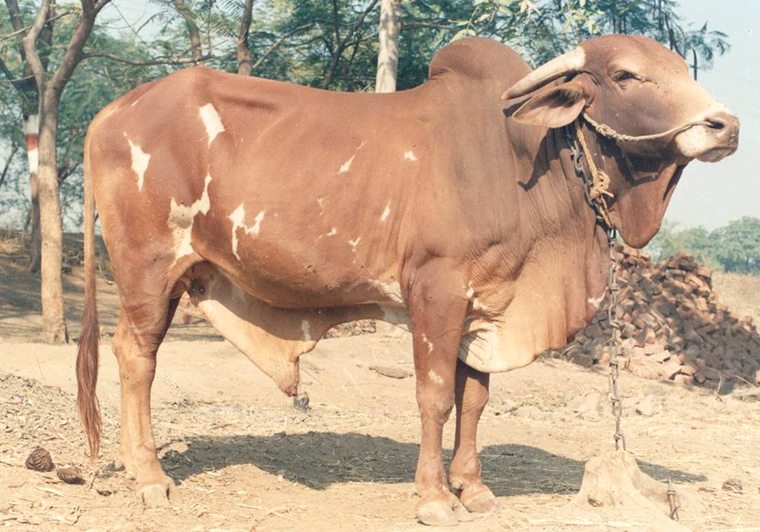
Bull
 Mainly in Central parts of Khargaon, Badwani districts and very few in the bordering Dhar district and adjacent areas of Madhya Pradesh and adjoining districts of Maharashtra state.
Mainly in Central parts of Khargaon, Badwani districts and very few in the bordering Dhar district and adjacent areas of Madhya Pradesh and adjoining districts of Maharashtra state.
 Originated from crossing of Gir and Khillari. Gir blood has contributed to its coat colour, massive body structure and convexity of forehead, and Khillari blood to its hardiness, agility and temper. Named after place of its origin i.e. Nimar region
Originated from crossing of Gir and Khillari. Gir blood has contributed to its coat colour, massive body structure and convexity of forehead, and Khillari blood to its hardiness, agility and temper. Named after place of its origin i.e. Nimar region
 Brownish red (Copper colour) and white giving spotted appearance (Chitkabri)
Brownish red (Copper colour) and white giving spotted appearance (Chitkabri)
 Massive body structure, typical red colour with large splashes of white and bulging forehead.
Massive body structure, typical red colour with large splashes of white and bulging forehead.
 There are lot of grasses and cattle are sent for grazing. Bullocks are generally stall fed. In addition to harvested grasses, they are also fed concentrates such as cotton seed, crushed chickpeas and GNC or sesam cakes. In winter all the cattle are stall fed. Green sorghum is extensively fed. During scarcity period, tree lopping are given. Special attention is paid to the rearing of male calves as they from an important source of income to the farmers. Males are usually castrated and put to light work at about 36 to 42 months of age. Only few cows are milked while the rest feed calves only.
There are lot of grasses and cattle are sent for grazing. Bullocks are generally stall fed. In addition to harvested grasses, they are also fed concentrates such as cotton seed, crushed chickpeas and GNC or sesam cakes. In winter all the cattle are stall fed. Green sorghum is extensively fed. During scarcity period, tree lopping are given. Special attention is paid to the rearing of male calves as they from an important source of income to the farmers. Males are usually castrated and put to light work at about 36 to 42 months of age. Only few cows are milked while the rest feed calves only.
- ONGOLE ( Nellore )
-
ORIGIN : Andhra Pradesh
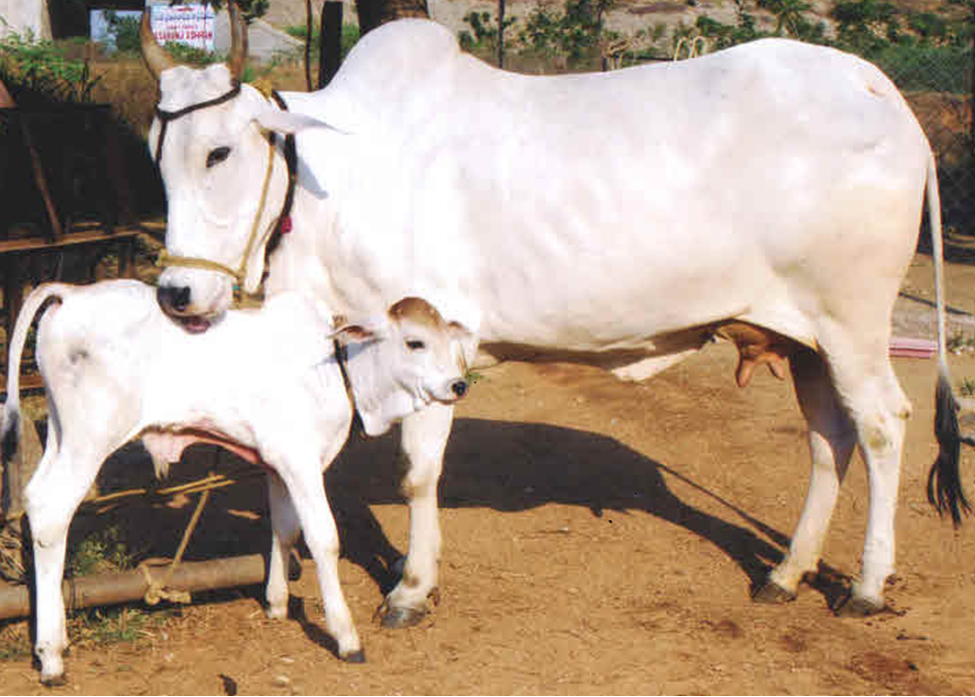
Cow
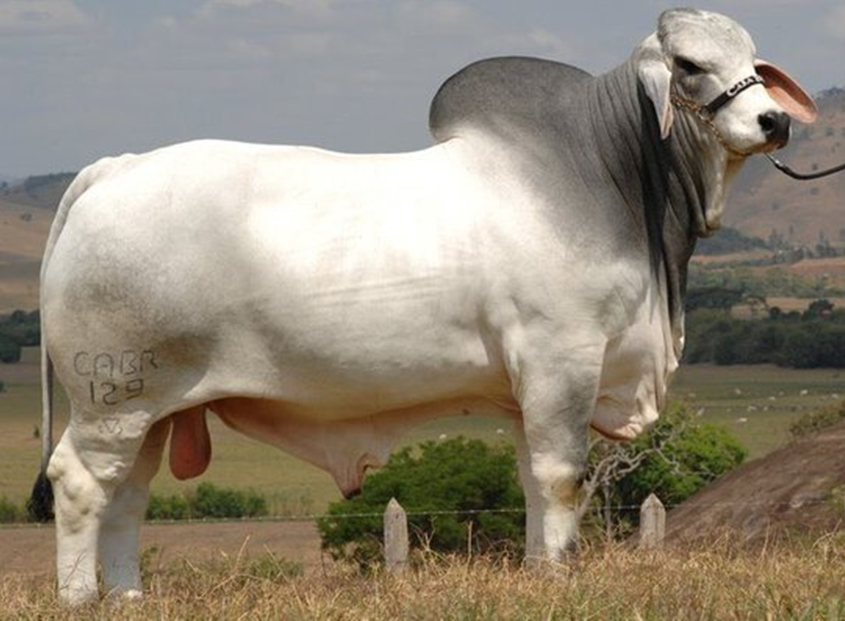
Bull
 The breeding tract extends all along the coast from Nellore to Vizianagram
The breeding tract extends all along the coast from Nellore to Vizianagram
 Ongoles have been exported to several countries. USA imported it for beef; Brazil for beef and milk; Sri Lanka, Fiji and Jamaica for draught; Australia for heat tolerance and beef; and Switzerland for disease resistance.
Ongoles have been exported to several countries. USA imported it for beef; Brazil for beef and milk; Sri Lanka, Fiji and Jamaica for draught; Australia for heat tolerance and beef; and Switzerland for disease resistance.
 TheOngole breed takes its name from the geographical area, Ongole, in which it is reared. It is also called the Nellore breed since the Ongole taluk was earlier included in Nellore district.
TheOngole breed takes its name from the geographical area, Ongole, in which it is reared. It is also called the Nellore breed since the Ongole taluk was earlier included in Nellore district.
 Ongole have a glossy white coat called padakateeru by the breeders. Males have dark grey markings on head, neck and hump, black points on knees and pasterns, black muzzle and black eye-lashes.
Ongole have a glossy white coat called padakateeru by the breeders. Males have dark grey markings on head, neck and hump, black points on knees and pasterns, black muzzle and black eye-lashes.
 Majestic gait, stumpy horns, large fan shaped and fleshy dewlap serrated with smooth flowing folds instead of narrow constrictions.
Majestic gait, stumpy horns, large fan shaped and fleshy dewlap serrated with smooth flowing folds instead of narrow constrictions.
 Cattle are sent for grazing in groups with professional grazers knowns as lambadis. Male calves are nursed better than female calves . They are allowed more milk and for longer duration as compared to female calves.Paddy straw and cultivated crops such as lentil are fed to animals. Stovers from sorghum are also fed. Cotton cakes and cotton seed are extensively used for cattle feeding.
Cattle are sent for grazing in groups with professional grazers knowns as lambadis. Male calves are nursed better than female calves . They are allowed more milk and for longer duration as compared to female calves.Paddy straw and cultivated crops such as lentil are fed to animals. Stovers from sorghum are also fed. Cotton cakes and cotton seed are extensively used for cattle feeding.
 The Nellore or Ongole breed hardiness, disease resistance and its capacity to thrive on scanty and dry fodder have been quite successfully exploited for improvement and upgrading their local stock by many countries
The Nellore or Ongole breed hardiness, disease resistance and its capacity to thrive on scanty and dry fodder have been quite successfully exploited for improvement and upgrading their local stock by many countries
- PONWAR ( Purnea )
-
ORIGIN : UTTAR PRADESH
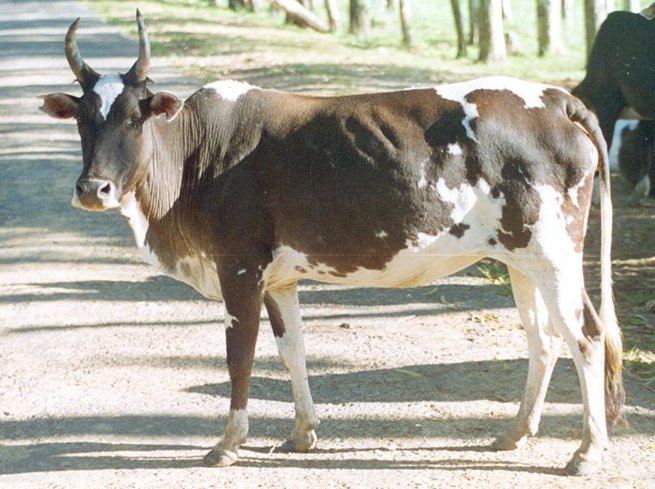
Cow
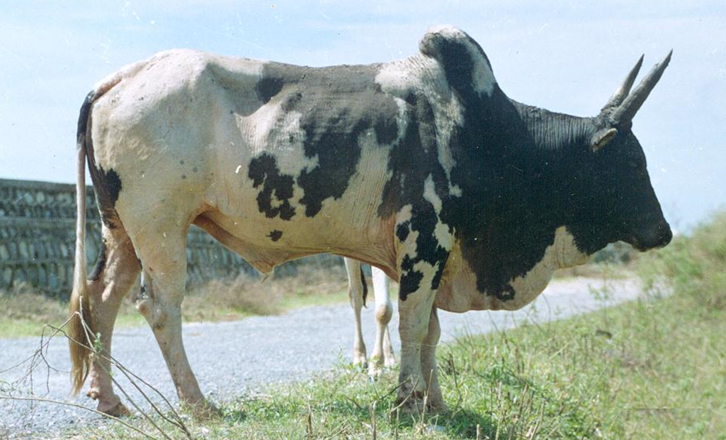
Bull
 This breed is found in the Puranpur tehsil of Pilibhit district. Animals true to the breed are found in Mainakot, Mazara, Bhirkhera, Faizulaganj and Rajpur Semra villages falling under Madhotanda veterinary Hospital area of Puranpur.
This breed is found in the Puranpur tehsil of Pilibhit district. Animals true to the breed are found in Mainakot, Mazara, Bhirkhera, Faizulaganj and Rajpur Semra villages falling under Madhotanda veterinary Hospital area of Puranpur.
 Bullocks are fast mover, good for agricultural operations and good source of income to the farmers. This breed may be a mixture of hill cattle and plain cattle. Nepalese hill cattle (Morang) and local white cattle might have contributed to the origin of this breed.
Bullocks are fast mover, good for agricultural operations and good source of income to the farmers. This breed may be a mixture of hill cattle and plain cattle. Nepalese hill cattle (Morang) and local white cattle might have contributed to the origin of this breed.
 Ponwar cattle are usually brown or black with white patches. There is no particular pattern but black and white patches are intermixed.
Ponwar cattle are usually brown or black with white patches. There is no particular pattern but black and white patches are intermixed.
 Cattle are raised entirely on grazing in the forest area and no suplementary feed is provided . Animals of the whole village are taken for grazing by one or two persons. Females are not milked. Calves are allowed to suck all the milk. Bullocks are used for transportation and agricultural operations. Other stock is rarely handled. Animals are kept in the open.
Cattle are raised entirely on grazing in the forest area and no suplementary feed is provided . Animals of the whole village are taken for grazing by one or two persons. Females are not milked. Calves are allowed to suck all the milk. Bullocks are used for transportation and agricultural operations. Other stock is rarely handled. Animals are kept in the open.
- PUNGANUR
-
ORIGIN : Andhra Pradesh
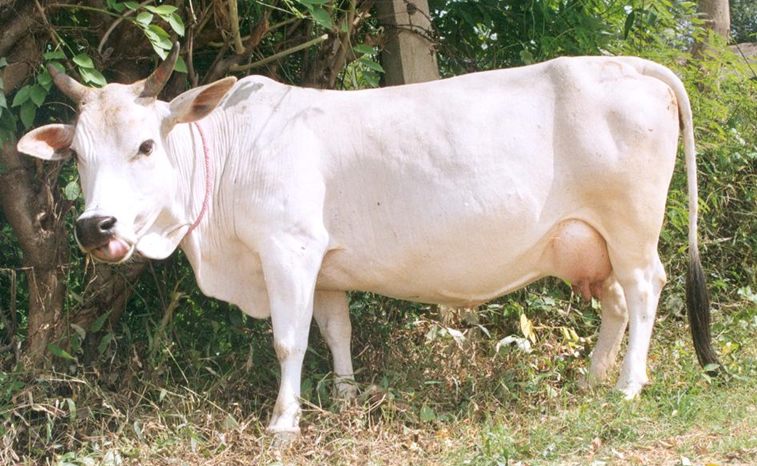
Cow
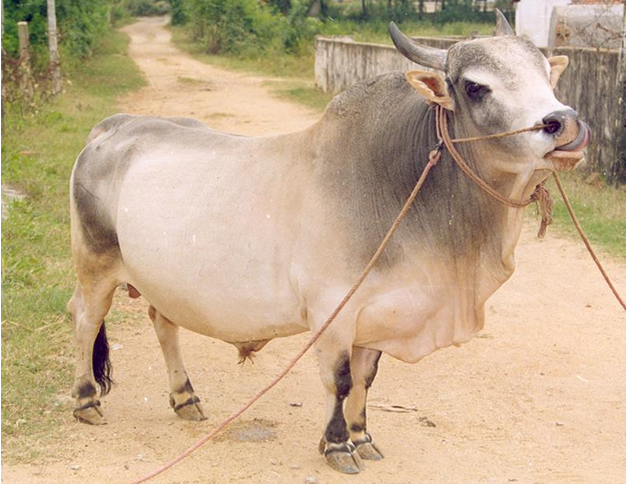
Bull
 The breed tract is confined to the taluks of Punganur and adjacent taluks of Vayalpad, Madnapalli and Palamaner in Chittoor district of Andhra Pradesh.
The breed tract is confined to the taluks of Punganur and adjacent taluks of Vayalpad, Madnapalli and Palamaner in Chittoor district of Andhra Pradesh.
 These animals are used for agricultural operations on light soil. Bullocks are used for carts like tongas and for special races.
These animals are used for agricultural operations on light soil. Bullocks are used for carts like tongas and for special races.
 This breed was developed by Rulers of Punganur. Hence this breed is known as Punganur after the name of area.
This breed was developed by Rulers of Punganur. Hence this breed is known as Punganur after the name of area.
 Punganur cattle are white, grey or light brown to dark brown or red. White mixed with red or black colour animals are also available. Combination of white with brown or black patches is not uncommon.It has a very Short stature. Dwarf cattle
Punganur cattle are white, grey or light brown to dark brown or red. White mixed with red or black colour animals are also available. Combination of white with brown or black patches is not uncommon.It has a very Short stature. Dwarf cattle
 Women and children of the family look after the animals. Animals are housed in a small shed made with the help of bamboos and stone pillars. Stacks of paddy straw and groundnut form the roof of cattle shed. Animals are housed only during the night and are grazed in the wastelands in the nearby forests. Soon after the harvest of paddy, animals are allowed to graze over paddy stubbles. Paddy straw forms the major component of fodder. In addition, sugarcane tops, ground nut halms, fingermillet straw and mulberry leaves are fed to cattle. Milking cows are fed concentrates at the time of milking.
Women and children of the family look after the animals. Animals are housed in a small shed made with the help of bamboos and stone pillars. Stacks of paddy straw and groundnut form the roof of cattle shed. Animals are housed only during the night and are grazed in the wastelands in the nearby forests. Soon after the harvest of paddy, animals are allowed to graze over paddy stubbles. Paddy straw forms the major component of fodder. In addition, sugarcane tops, ground nut halms, fingermillet straw and mulberry leaves are fed to cattle. Milking cows are fed concentrates at the time of milking.
- SIRI ( Trahbum )
-
ORIGIN : WEST BENGAL / SIKKIM
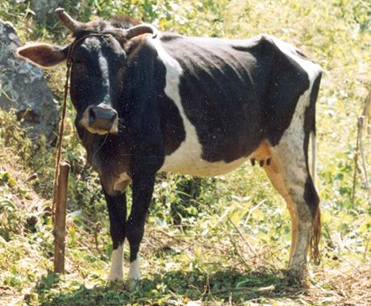
Cow
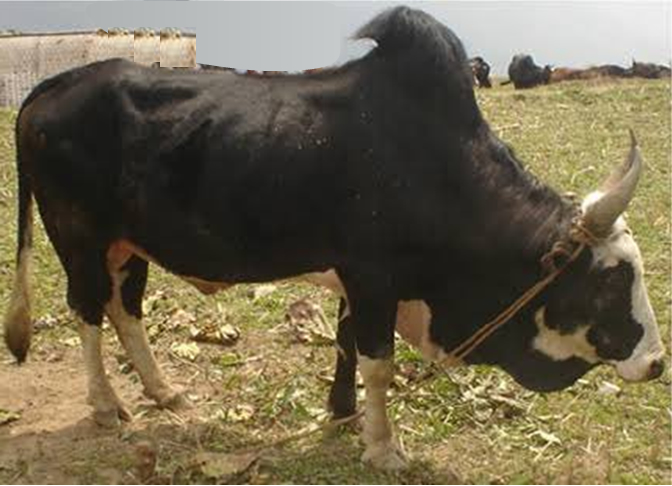
Bull
 Animals are either black with white patches or brown with white patches. In some cases they are totally black or brown.
Animals are either black with white patches or brown with white patches. In some cases they are totally black or brown.
 Colour pattern similar to that of Holstein Friesian, Cervico - thoracic type of hump covered with a tuft of hair.
Colour pattern similar to that of Holstein Friesian, Cervico - thoracic type of hump covered with a tuft of hair.
 Animals are mostly taken for grazing in the forests. Animals of the entire village are taken to forest by one person in the morning at about 7 a.m.. They graze on steep slopes in thic forest. Cows in milk return by the milking time. Animals are also fed leaves of the forest trees like khanyu, gogun, kairalo, chuletro, and residues of crops like ginger leaves and paddy straw. In few cases Napier and Gotamala grasses and maize are fed to animals. Milking cows are also fed home made concentrate, prepared by boiling together maize and rice grains, raddish with leaves, kuish fruits and mustard cake. This mixture is than offered to the animals as such. Animals are housed on the slope of hills in open houses which are small in size and have galvonised iron sheet roofs. Sheds are so small that an animals can hardly stand in it.
Animals are mostly taken for grazing in the forests. Animals of the entire village are taken to forest by one person in the morning at about 7 a.m.. They graze on steep slopes in thic forest. Cows in milk return by the milking time. Animals are also fed leaves of the forest trees like khanyu, gogun, kairalo, chuletro, and residues of crops like ginger leaves and paddy straw. In few cases Napier and Gotamala grasses and maize are fed to animals. Milking cows are also fed home made concentrate, prepared by boiling together maize and rice grains, raddish with leaves, kuish fruits and mustard cake. This mixture is than offered to the animals as such. Animals are housed on the slope of hills in open houses which are small in size and have galvonised iron sheet roofs. Sheds are so small that an animals can hardly stand in it.
- THARPARKAR ( White Sindhi, Grey Sindhi, Thari )
-
ORIGIN : Gujarat Rajasthan
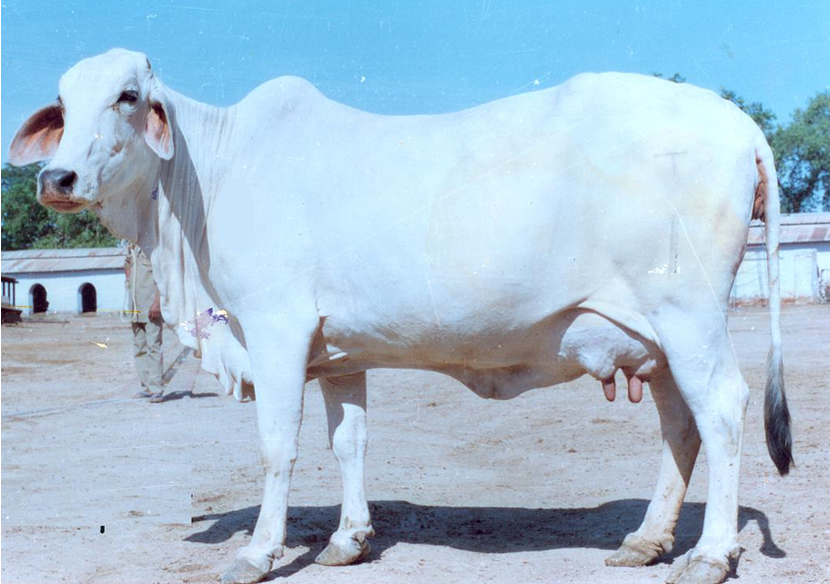
Cow
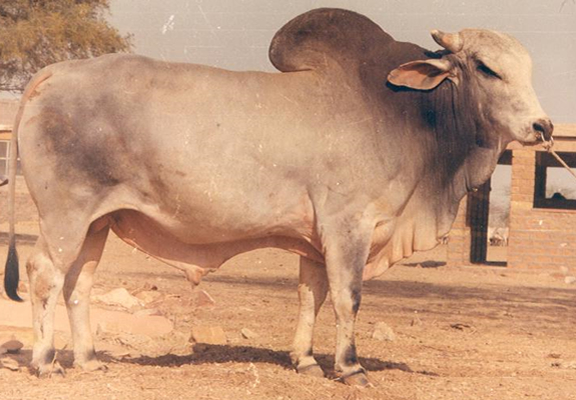
Bull
 Tharparkar animals are found along the Indo-Pak border covering Western Rajasthan and upto Rann of Kutch in Gujarat.
Tharparkar animals are found along the Indo-Pak border covering Western Rajasthan and upto Rann of Kutch in Gujarat.
 The name of Tharparkar has been derived from the place of its origin i.e. the Thar desert.
The name of Tharparkar has been derived from the place of its origin i.e. the Thar desert.
 Well adapted to harsh agro-climatic conditions of the Thar desert.
Well adapted to harsh agro-climatic conditions of the Thar desert.
 Animals are white or light grey. Face and extremities are of a darker shade than the body. In bulls neck, hump, and fore and hind quarters are also dark.
Animals are white or light grey. Face and extremities are of a darker shade than the body. In bulls neck, hump, and fore and hind quarters are also dark.
 Convex forehead.
Convex forehead.
 This area suffers from endemic scarcity of fodder and water which becomes acute during summer season particularly between April and June. The whole area is sandy bereft of vegetation except small bushes. Only at a few places kheri or khejri trees are available. Sewan is the only staple fodder available, either as green grass or hay. Concentrate is offered only to cows in advance pregnancy or to lactating cows. Animals are generally not provided with shelter or houses throughout the year, except during certain chilly nights or during extreme summer season. Animal houses are made of Kutcha walls and have thatched roof of senia grass. There is no planned mating system but usually farmers select bulls on the basis of phenotype and sometimes on milk yield of the dam.
This area suffers from endemic scarcity of fodder and water which becomes acute during summer season particularly between April and June. The whole area is sandy bereft of vegetation except small bushes. Only at a few places kheri or khejri trees are available. Sewan is the only staple fodder available, either as green grass or hay. Concentrate is offered only to cows in advance pregnancy or to lactating cows. Animals are generally not provided with shelter or houses throughout the year, except during certain chilly nights or during extreme summer season. Animal houses are made of Kutcha walls and have thatched roof of senia grass. There is no planned mating system but usually farmers select bulls on the basis of phenotype and sometimes on milk yield of the dam.
- VECHUR ( Vechur Kuttai )
-
ORIGIN : Kerala
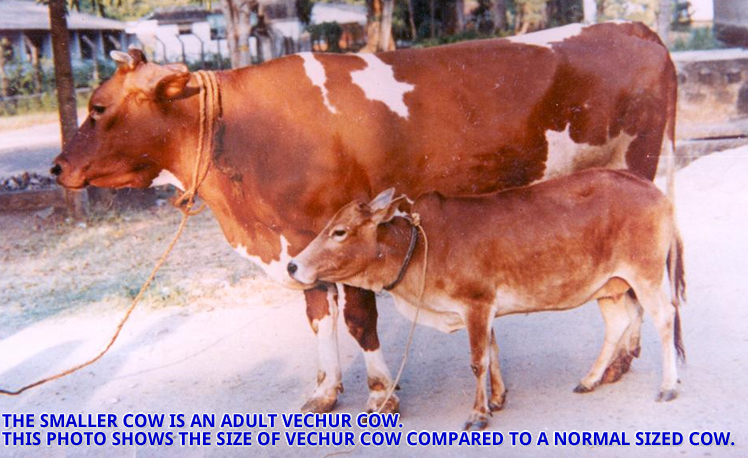
Cow
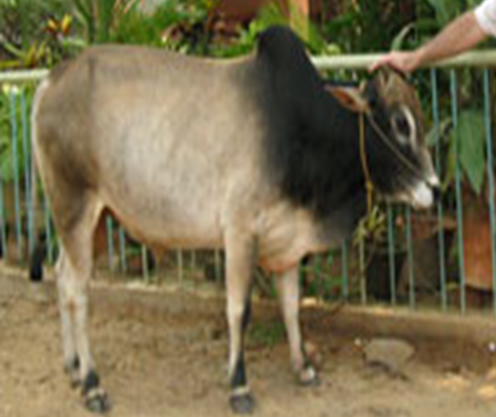
Bull
 Kuttanad, a unique agricultural tract, which covers Alappuzha, Kottayam and Pathanamthitta; and Kasaragod districts of Kerala
Kuttanad, a unique agricultural tract, which covers Alappuzha, Kottayam and Pathanamthitta; and Kasaragod districts of Kerala
 Milk production in Vechur cattle is relatively higher than in other dwarf cattle available in this area.
Milk production in Vechur cattle is relatively higher than in other dwarf cattle available in this area.
 It is known by the name of a place Vechur - a small place by the side of Vembanad lake near Vaikam in Kottayam district of South Kerala.
It is known by the name of a place Vechur - a small place by the side of Vembanad lake near Vaikam in Kottayam district of South Kerala.
 The social requirement as well as heavy rain and hot humid climate of the area coupled with low input available to the animals led to the selection of a small adaptable animal by man as well nature. This was the basis for evolution of Vechur animal.
The social requirement as well as heavy rain and hot humid climate of the area coupled with low input available to the animals led to the selection of a small adaptable animal by man as well nature. This was the basis for evolution of Vechur animal.
 Animals are light red, black or fawn and white.
Animals are light red, black or fawn and white.
 Extremely small sized animal with compact body.(dwarf catlle)
Extremely small sized animal with compact body.(dwarf catlle)
 Smallest cattle in the World.
Smallest cattle in the World.
 Animals from each house are let loose in the morning. These animals herd together and go for grazing in bigger groups. Breeding bulls are also present in the grazing area. Cows conceive out of natural mating from these bulls. Animals return home in the evening. Generally animals are confined to sheds in the night. Tree leaves are spread in sheds as breeding. Additional leaves are spread on alternate days on the previous layer. Daily cleaning of sheds is not done as in other parts of state. Manure is removed 3 or 4 times a year and used as mulch (organic manure) for cultivation.
Animals from each house are let loose in the morning. These animals herd together and go for grazing in bigger groups. Breeding bulls are also present in the grazing area. Cows conceive out of natural mating from these bulls. Animals return home in the evening. Generally animals are confined to sheds in the night. Tree leaves are spread in sheds as breeding. Additional leaves are spread on alternate days on the previous layer. Daily cleaning of sheds is not done as in other parts of state. Manure is removed 3 or 4 times a year and used as mulch (organic manure) for cultivation.

